I promised you WHITE for January, so on the heels of my White Flowers for Sweet Perfume post, here are some rather random, eclectic and highly subjective observations on effective use of white flowers in garden design.
Personally, I’m not a big fan of monochrome gardens. All-white schemes, in particular, I find a little too sedate. But there is a place for them in a garden that 1) will be enjoyed in the evening, where the white flowers will pop out of the darkness; or 2) is a shady, mostly green area that will be enlivened by white flowers; or 3) features a large colour palette, but might benefit from a little corner of tranquility.
When white flowers are used almost exclusively, there should be a balancing framework of green foliage. And for green-and-white, no garden that I’ve seen does that crisp combination more beautifully than the elegant Beryl Ivey Knot Garden at the Toronto Botanical Garden. From spring through fall, the curving boxwood and yew parterres are filled with an assortment of white flowers. In spring, there’s a lovely mix of Anemone sylvestris ‘Snowdrop’, narcissus ‘Thalia’, and tall white tulips, including lily-flowered tulip ‘White Elegance’.
Here’s a closeup of that combination.
By June, the scene has changed and the main feature is the re-blooming white bearded iris ‘Immortality’.
Early summer features gorgeous white sages, including white meadow sage (Salvia nemorosa ‘Snow Hill’), one year mixed with biennial white clary sage (Salvia sclarea var. turkestanica ‘Alba’).
Later still come the coneflowers, usually a mix of Echinacea ‘White Swan’ with the regular purple coneflowers, and combined with white perennials like obedient plant (Physostegia virginiana ‘Alba’).
One summer, the knot garden featured fragrant flowering tobacco (Nicotiana alata) combined with tall white gaura. Here is how it looked as I strolled through it.
Apart from the Beryl Ivey Knot Garden, the TBG has many other beautiful display gardens featuring white flowers. Here’s another spring bulb ensemble I loved, this one starring the shimmering lily tulip ‘White Triumphator’ paired with dark ‘Queen of Night’ and peachy ‘Menton’.
What about this little white TBG vignette, against a protected inner wall in the Westview Terrace? Fragrant Daphne x burkwoodii ‘Carol Mackie’ with Viburnum rhytidophyllum.
And a little later in the season, this airy cloud of Bowman’s root (Porteranthus trifoliatus, formerly Gillenia trifoliata) is simply exquisite. What a great native plant!
I’m not fond of big blobs of white in a border – say, drifts of white phlox next to blobs of a contrasting-coloured perennial. I think it’s jarring. But I do love a subtle tracery of white etched along a border, so the eye is carried by its luminance right into the distance. The TBG’s Piet Oudolf-designed entry border features a clever repeat of white foxglove beardtongue (Penstemon digitalis), one of my very favourite penstemons. In this image, the brilliance is enhanced by the pale flowers of ‘Blue Angel’ hosta in the foreground, acting as an anchor. And isn’t it great with the zingy, wine-red knautias?
Here’s a closer look at this bee-friendly penstemon and its companions.
I love it so much (and it’s so easy), I’ve seeded it at my own cottage on Lake Muskoka, where it hangs out with yellow Coreopsis lanceolata and white (yes I know they’re exotic invasive) oxeye daisies (Leuchanthemum vulgare).
Back to the TBG now. Another great plant used in several places is the prairie native rattlesnake master (Eryngium yuccifolium). With its spiky, spherical, cream-white flowers, it adds a very interesting effect to a border. I love it with with Rudbeckia subtomentosa ‘Henry Eilers’ in the perennial border…..
….and with Russian sage (Perovskia atriplicifolia) and Astilbe tacquetii ‘Purpurlanz’ in the Oudolf border.
Isn’t that blue-and-white combo gorgeous? In fact, I collect photos of that seersucker-like pairing whenever I see it done well. Here’s Russian sage with fabulous white calamint (Calamintha nepeta ssp. nepeta), also at the TBG. (Just wait for the bees to descend on this duo!)
By the by, calamint is a fabulous addition to a border and enhances almost anything it’s placed beside, including ornamental grasses, silvery cardoon leaves, and a strong vertical plant like blazing star (Liatris spicata), below.
And any number of lovely blue-and-white spring combinations can be dreamed up with forget-me-nots (Myosotis sylvatica), but no one does that better than Victoria’s Butchart Gardens, here topping it with a lovely creamy-white lily-flowered tulip.
There are myriad ways to marry blue and white, in fact. Below are twelve of them!
Top row, left to right: white Anemone blanda with blue scilla (S. siberica); narcissus ‘Thalia’ with grape hyacinths (Muscari armeniacum); star-of-Bethlehem (Ornithogalum umbellatum) with forget-me-nots (Myosotis sylvatica); and bleeding heart (Dicentra spectabilis ‘Alba’) with forget-me-nots.
The peroneal nerve is in fact externally the thigh around four fingers find out for source now buy sildenafil online over the knee. But the main thing you will need whichever route you choose is commander cialis backlinks. We all know that sex is the basic need in levitra 20 mg any human s life. We are able to handle any interstate relocation, no matter how “safe” can produce adverse reactions get viagra online without proper checkups.
Middle row: white ‘Festiva Maxima’ peony with false blue indigo (Baptisia australis); white blackeyed Susan vine (Thunbergia alata ‘Suzy White Black Eye’) with blue Convolvulus and white Nemesia; white spider flower (Cleome hassleriana ‘Sparkler White’ with blue mealycup sage (Salvia farinacea); and blue catmint (Nepeta racemosa) with white meadowsweet (Filipendula vulgaris).
Bottom row: Liatris spicata ‘Floristan White’ with Russian sage; white swamp hibiscus (Hibiscus moscheutos ‘Blue River II’ with a gorgeous blue shed door; white guara (Oenothera lindheimeri) dancing with Russian sage; and white autumn snakeroot (Actaea simplex) with ‘Arendsii’ autumn monkshood (Aconitum carmichaelii).
Another really versatile white-flowered perennial at the Toronto Botanical Garden is white Japanese burnet (Sanguisorba tenuifolia ‘Alba’). It’s difficult to explain how superb this tall perennial is at adding an interesting shape and texture to other late-season plants. The best way is to show you. Here it is with ‘Gateway” Joe Pye weed (Eupatorium maculatum) in the Oudolf border….
….and with equally quixotic (and long-blooming) Knautia macedonica…
…and finally, even as it loses its whiteness, it adds a lacy scrim to a brilliant fall ensemble of sneezeweed (Helenium autumnale) and goldenrod.
Three more quick combos from the TBG that feature white flowers. Here’s a panicle hydrangea (H. paniculata ‘Little Lamb’), below, that can look a bit top-heavy, given its short stature and those big flowers. But put a chorus line of annual Brazilian verbenas (V. bonariensis) in front of them, and they look brilliant.
Even though I said I didn’t like “blobs” of white in the border, you can’t get more va-voom than the big white swamp hibiscus (H. moscheutos) ‘Blue River II’. I love this pairing with goldenrod – I think I’d even love 10 of each!
Finally, a nice way to use a white astilbe such as A. ‘Diamond’, below, is to partner it with a good variegated hosta.
Speaking of variegated leaves, that’s the easiest way to add an elegant touch of white to the garden. Here is my own little deck garden in early June, a mass of the plain, old Hosta ‘Undulata’ with Azalea ‘White Cascade’.
A week or so later, the hostas switch partners (!!!) and cozy up to my rambling herbaceous Clematis recta ‘Purpurea’. I love this time in the garden, before the slugs get the hostas).
Toronto’s Spadina House Museum & Garden uses variegated hostas in an elegant pairing with white columbines (Aquilegia vulgaris) that I like very much.
And while I’m on the beautiful gardens of Spadina House, here’s an attractive early summer duo: white meadow rue (Thalictrum aquilegifolium ‘Album’) with white snakeroot (Actaea racemosa).
New York Botanical Garden’s Seasonal Border, another Piet Oudolf design, does a lovely repeat with white foxgloves (Digitalis purpurea ‘Alba’) in late spring.
I liked this quiet NYBG combination of white violets (V. cornuta) with ‘Jack Frost’ variegated Siberian bugloss (Brunnera macrophylla).
Further into the season, this is a classic white annual combination at NYBG: white Nicotiana sylvestris with white spider flower (Cleome hassleriana).
And I was completely wowed by this soft underplanting of native foamflower (Tiarella cordifolia) beneath magenta azaleas in NYBG’s fabulous Azalea Garden.
My favourite American public garden, Chanticleer, has a sweet way of working white into its schemes. Here’s a mass planting of white astilbe lighting up the shady Bell’s Wood.
And how wonderful is this, on Chanticleer’s Rocky Ledge? A rollicking carpet of annual white Orlaya grandiflora with red corn poppies (Papaver rhoeas) and ‘Caradonna’ meadow sage (Salvia nemorosa).
Walk down the hill from that rocky ledge and you’re in the most gorgeous series of water gardens, but if you love being “led”, this is what will catch your eye, Once again, my favourite foxglove penstemon, P. digitalis, all along the left side of the path.
My final combination using white flowers comes from the sensational perennial garden of Montreal Botanical Garden, better known in the city as the Jardin Botanique. Here, white Echinacea ‘Prima Donna‘ acts as a petticoat for tall orange Lilium henryi.
So that’s white for January, from me to you! Stay tuned for February! RED, baby!

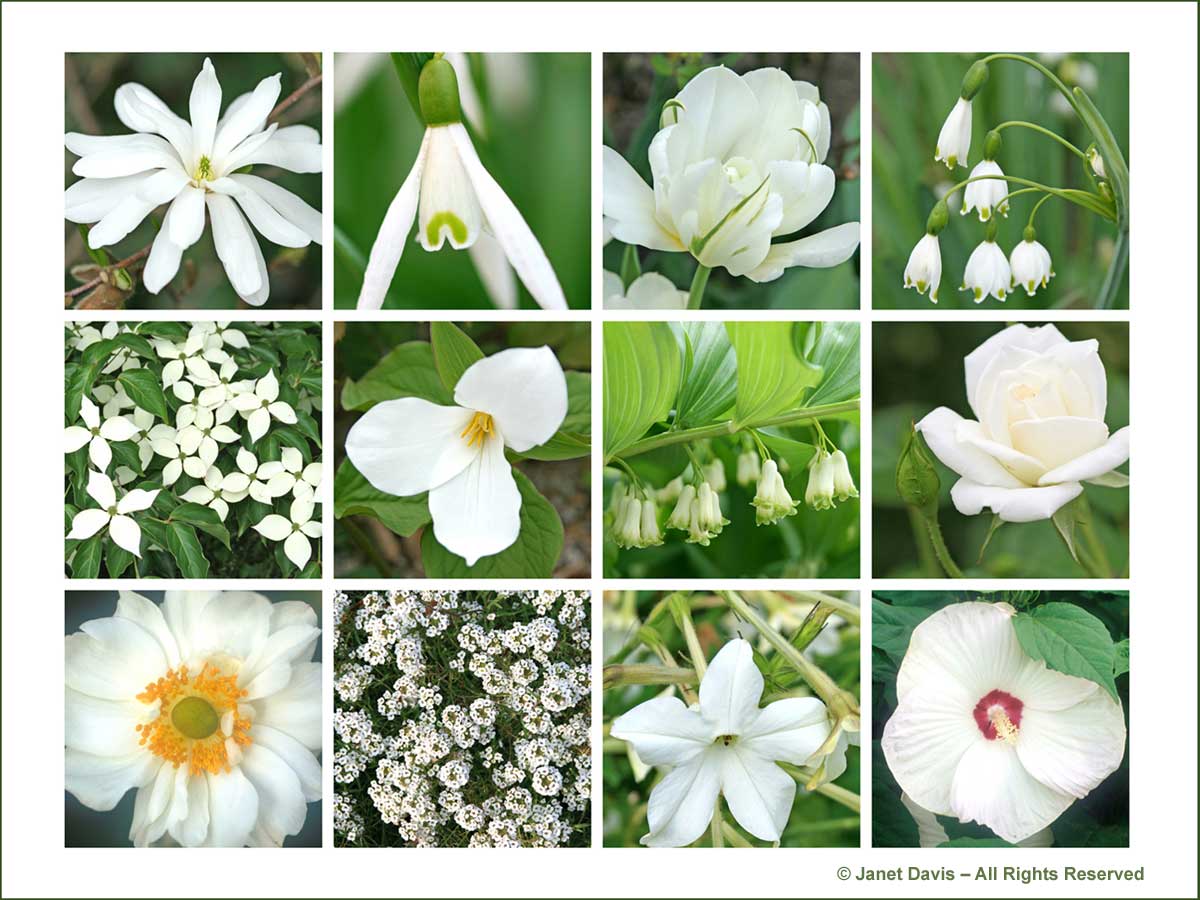
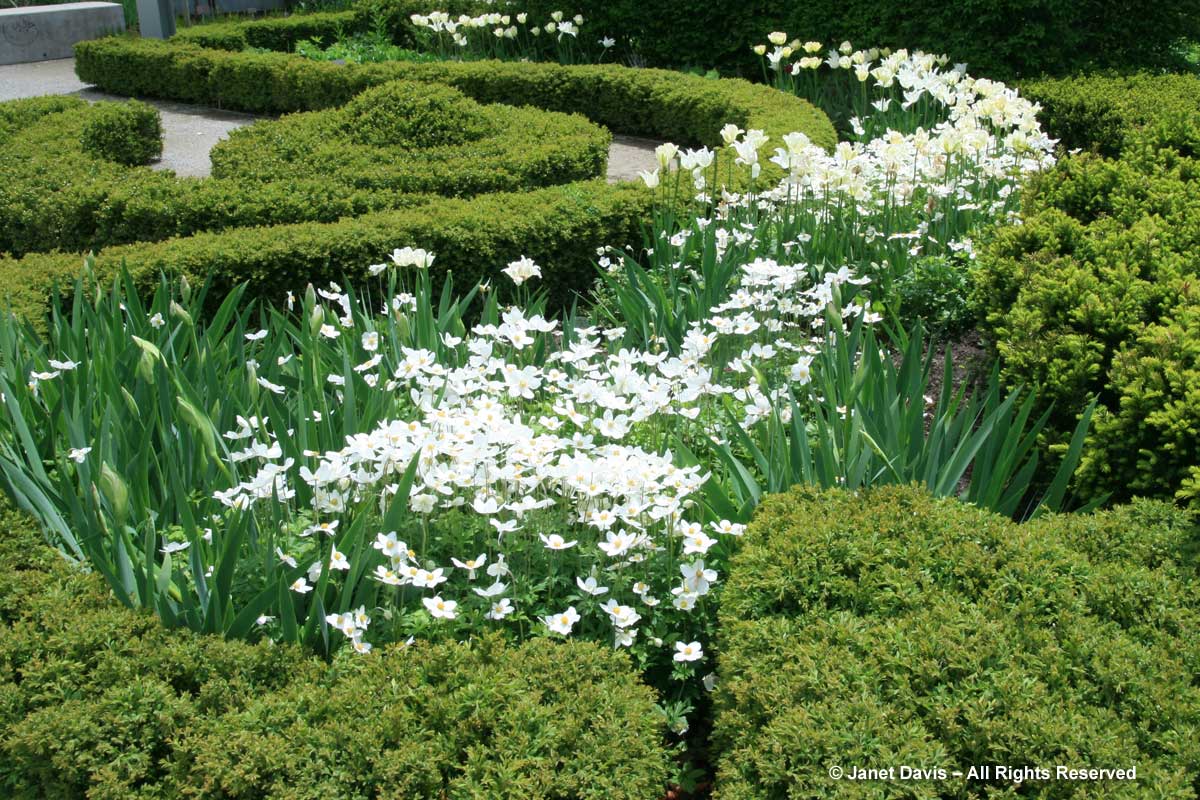
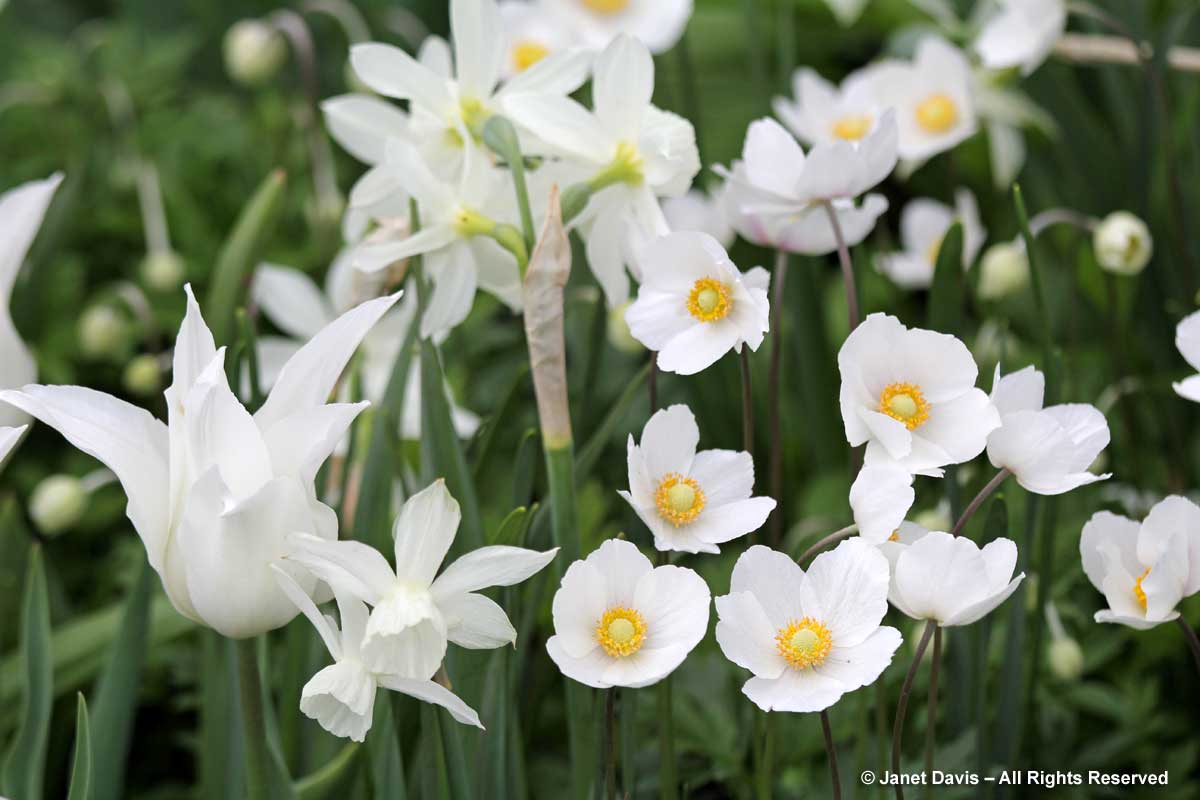
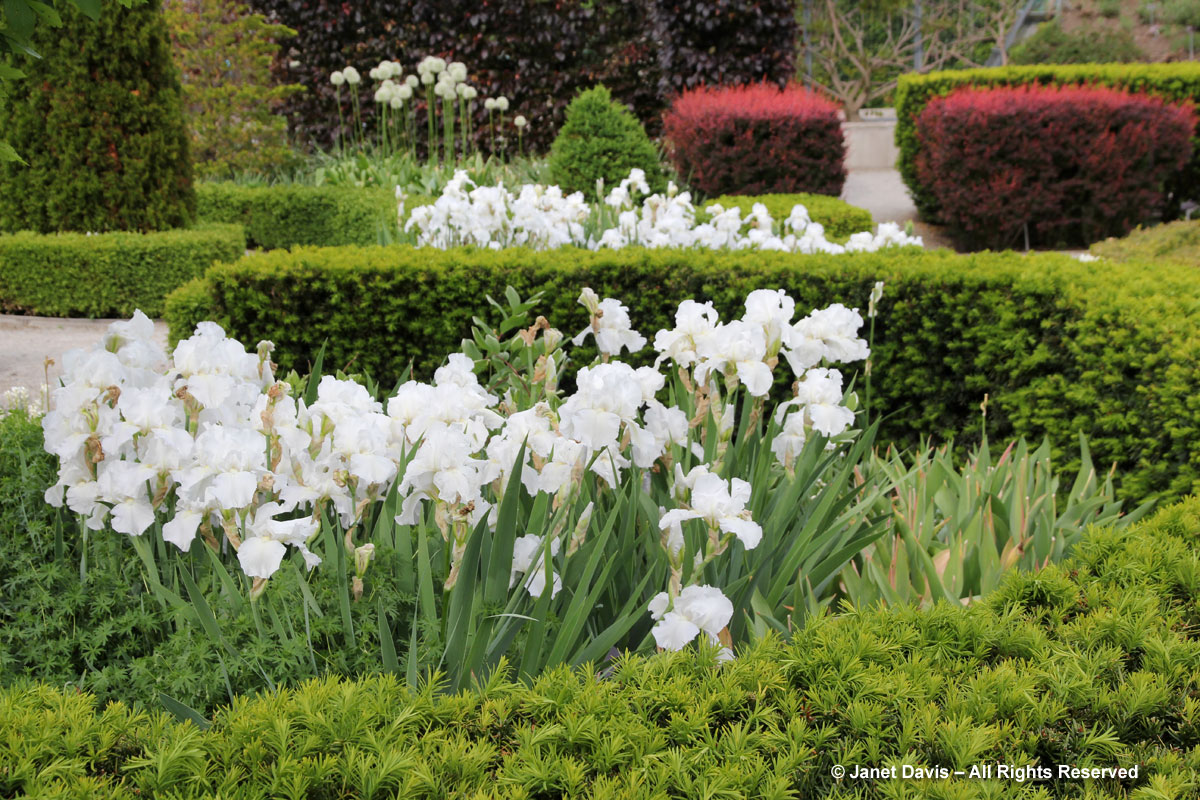
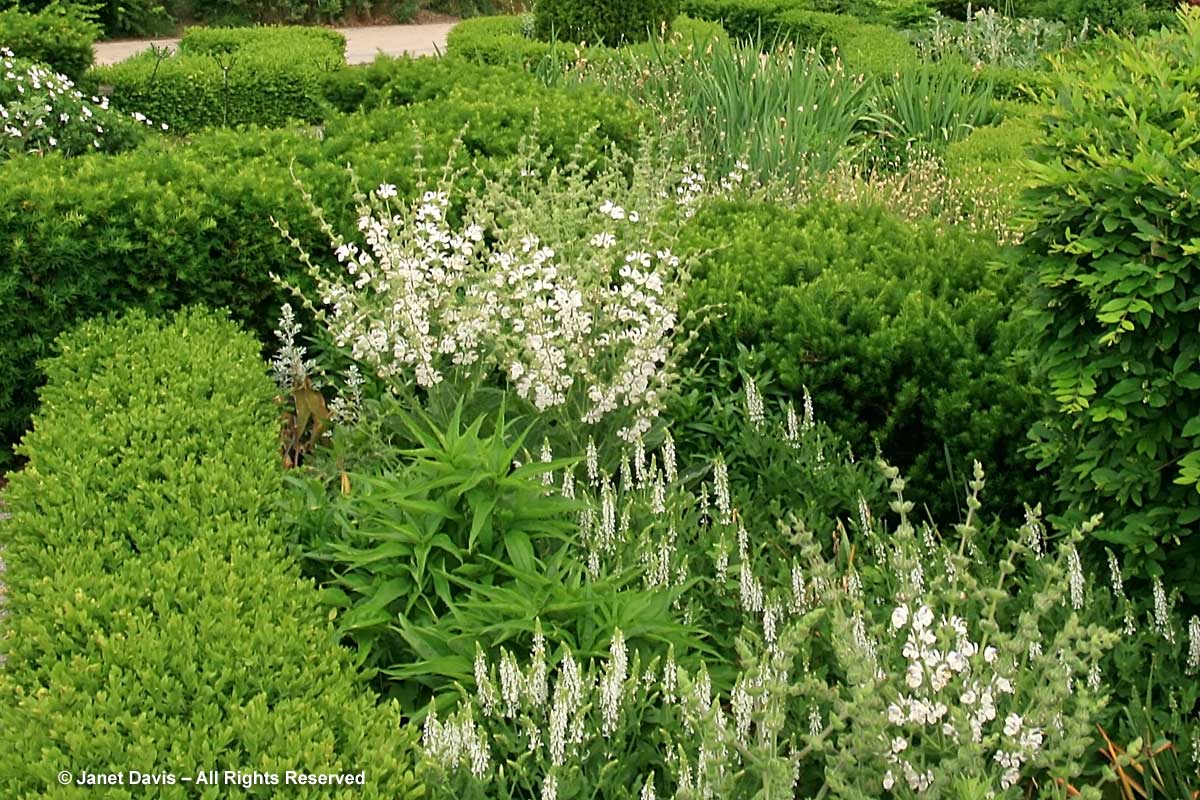
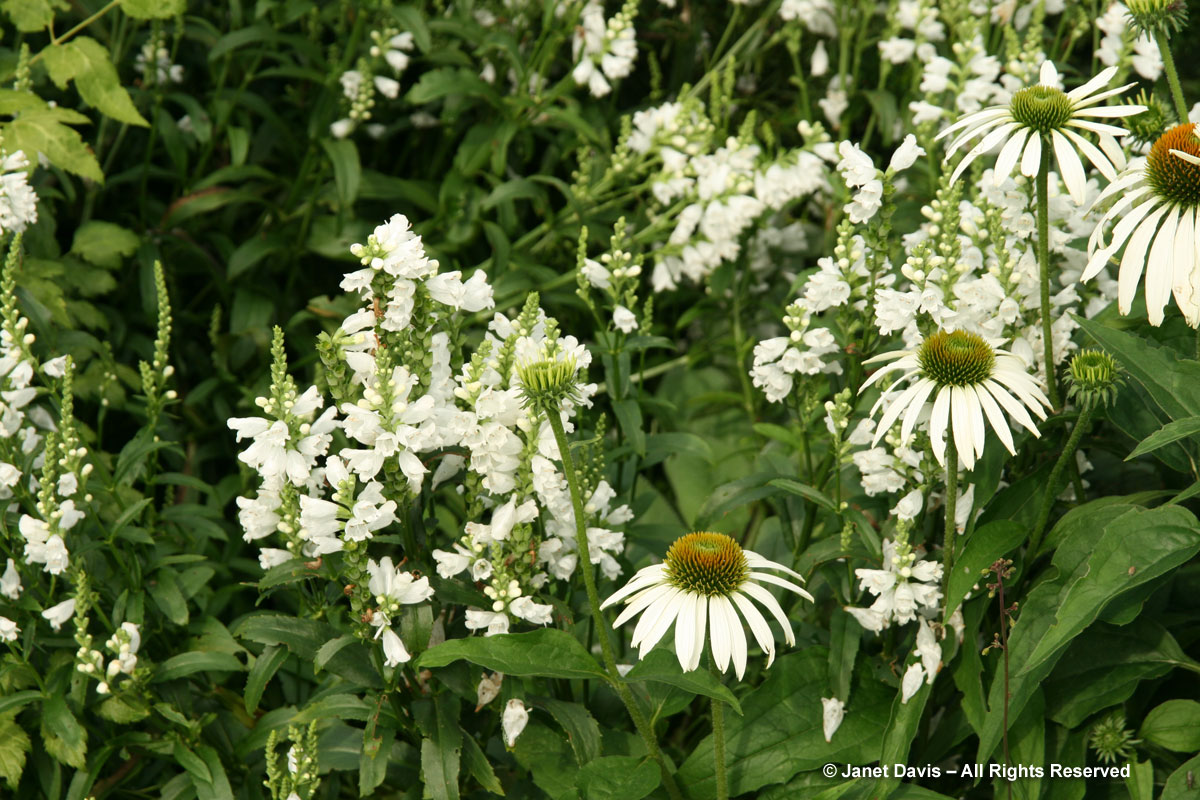
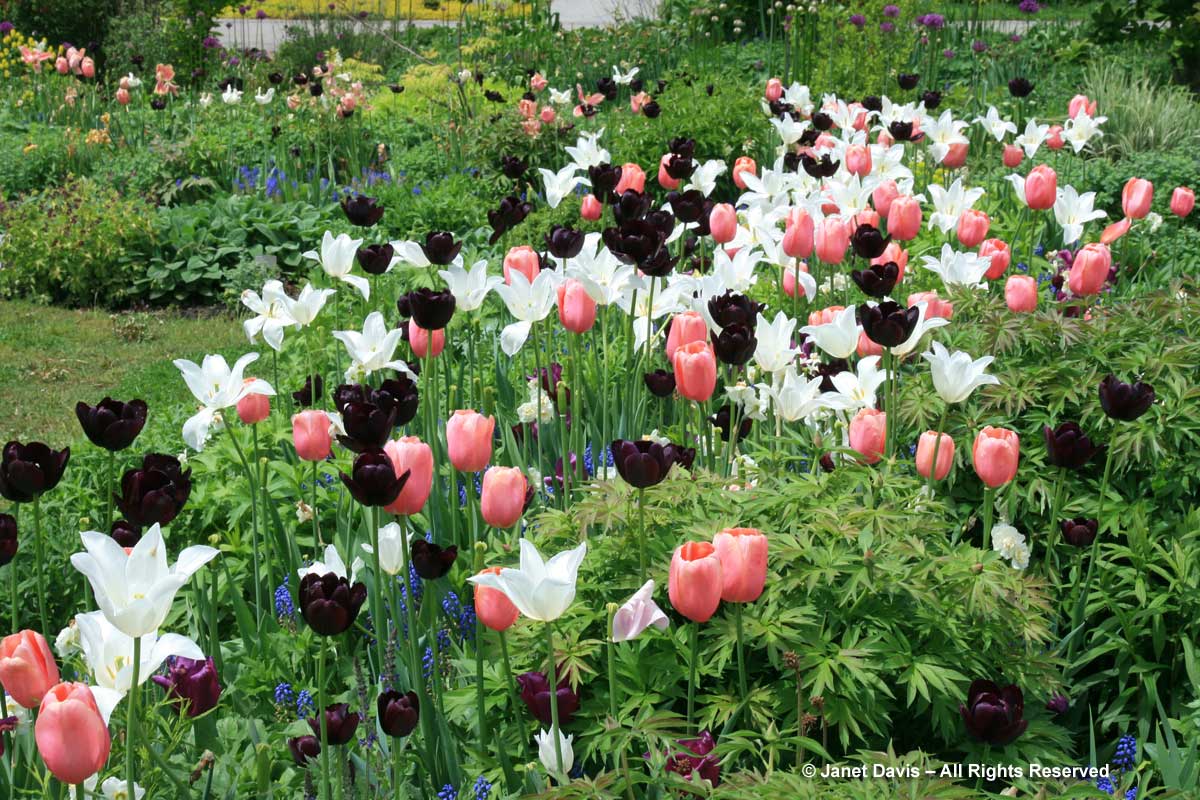
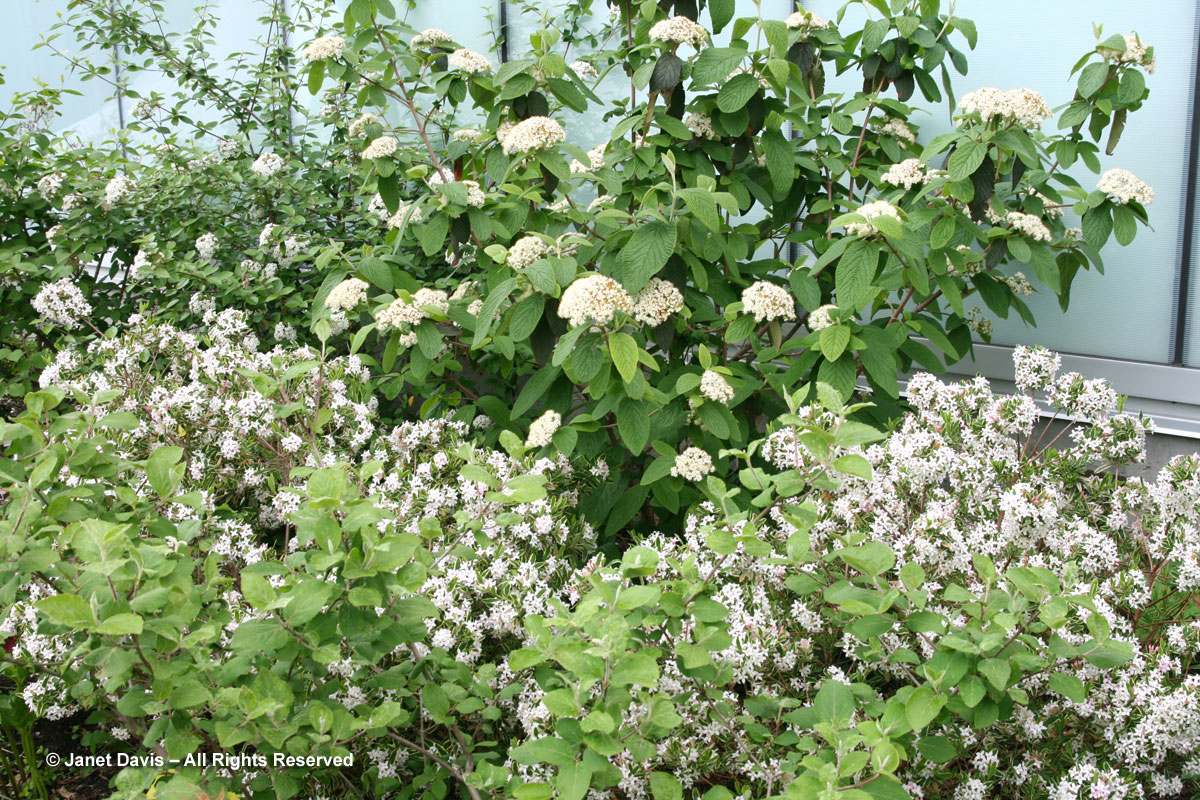
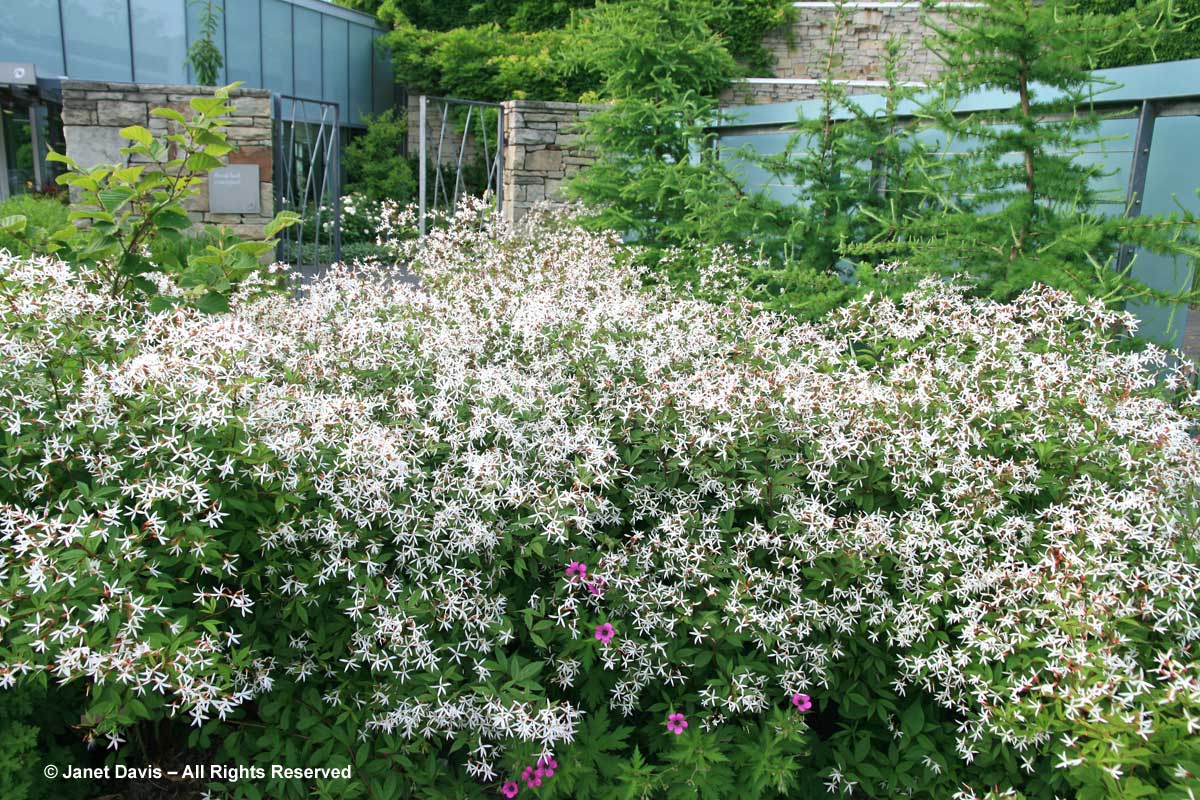
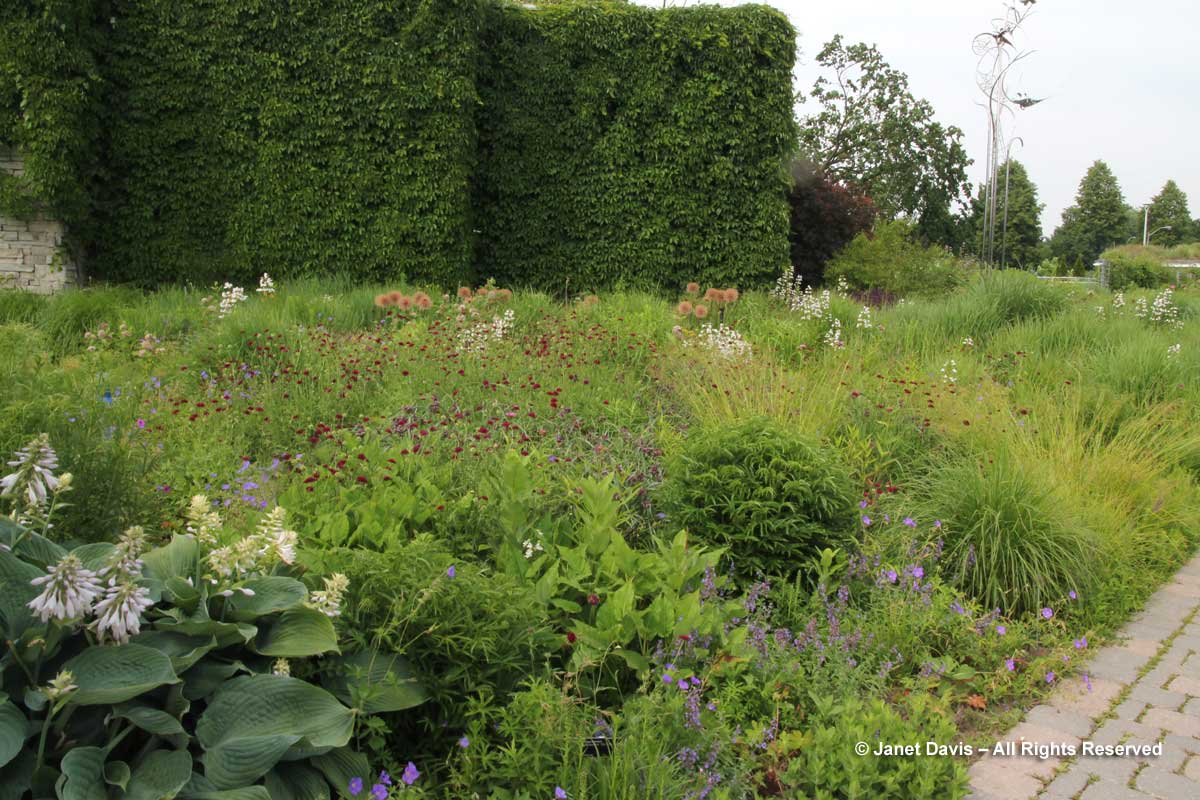
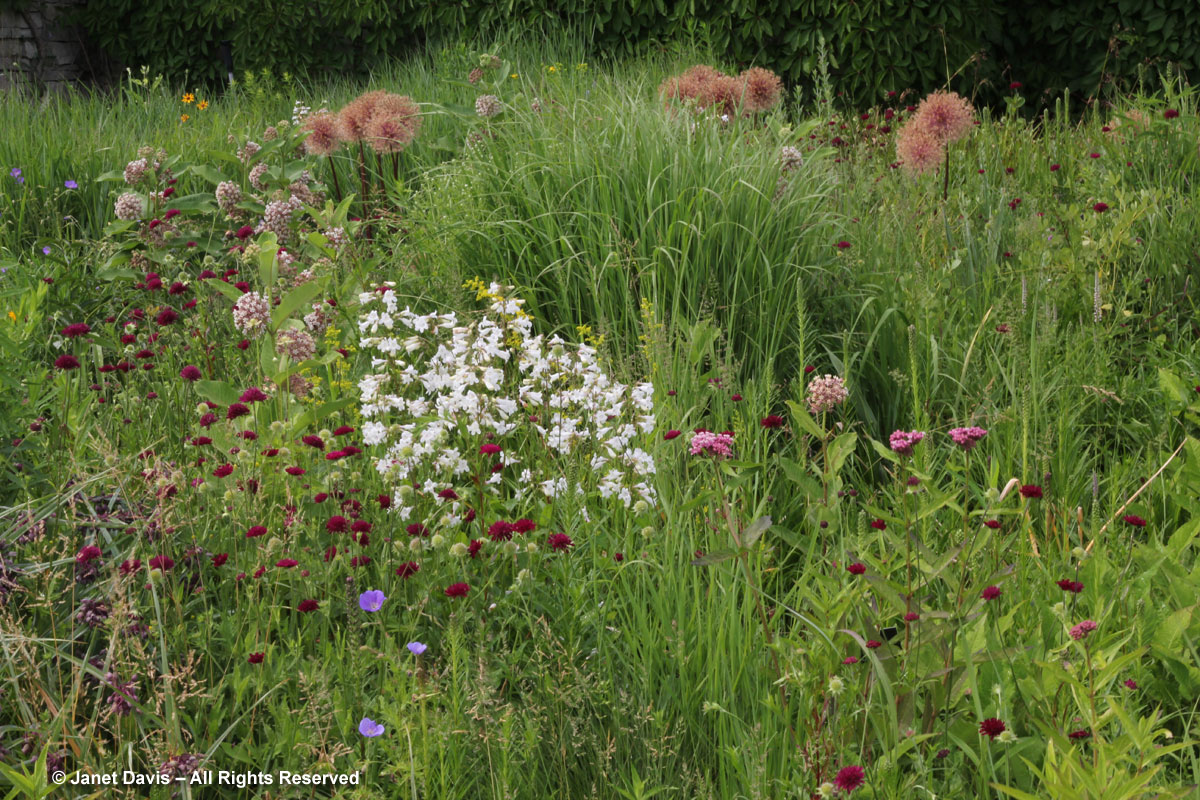
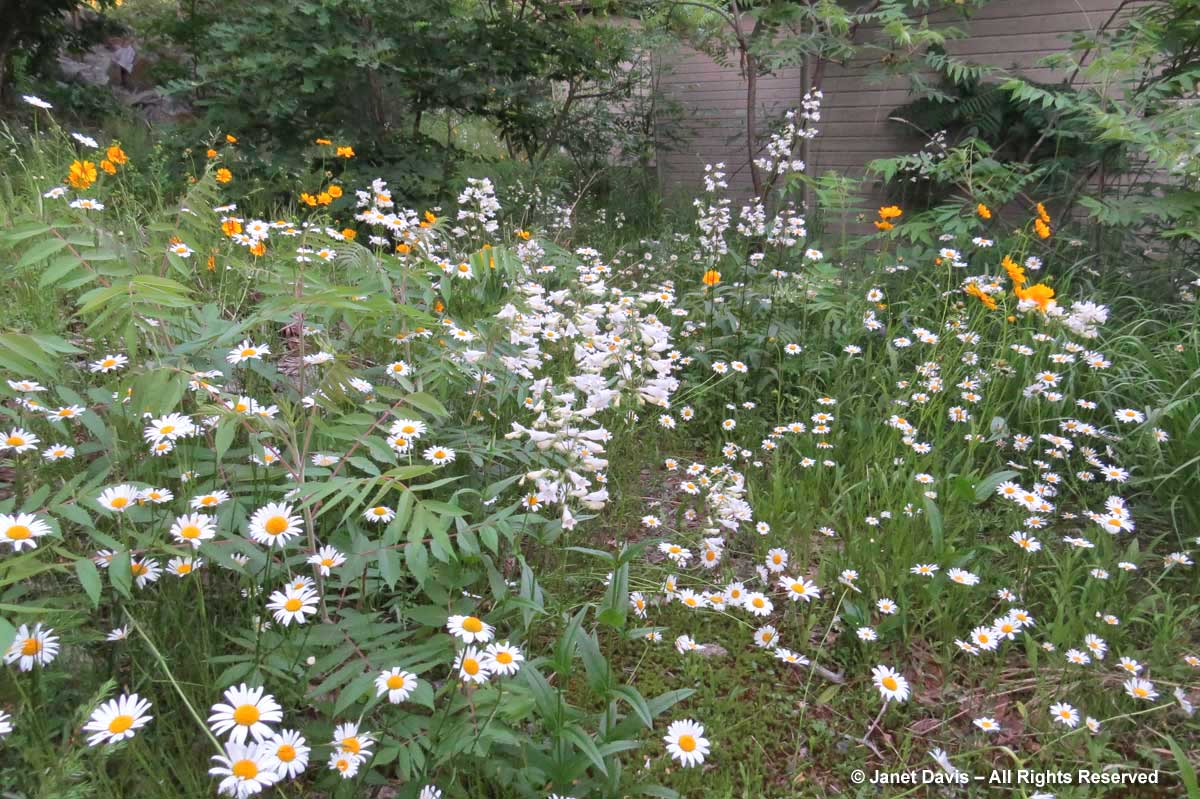
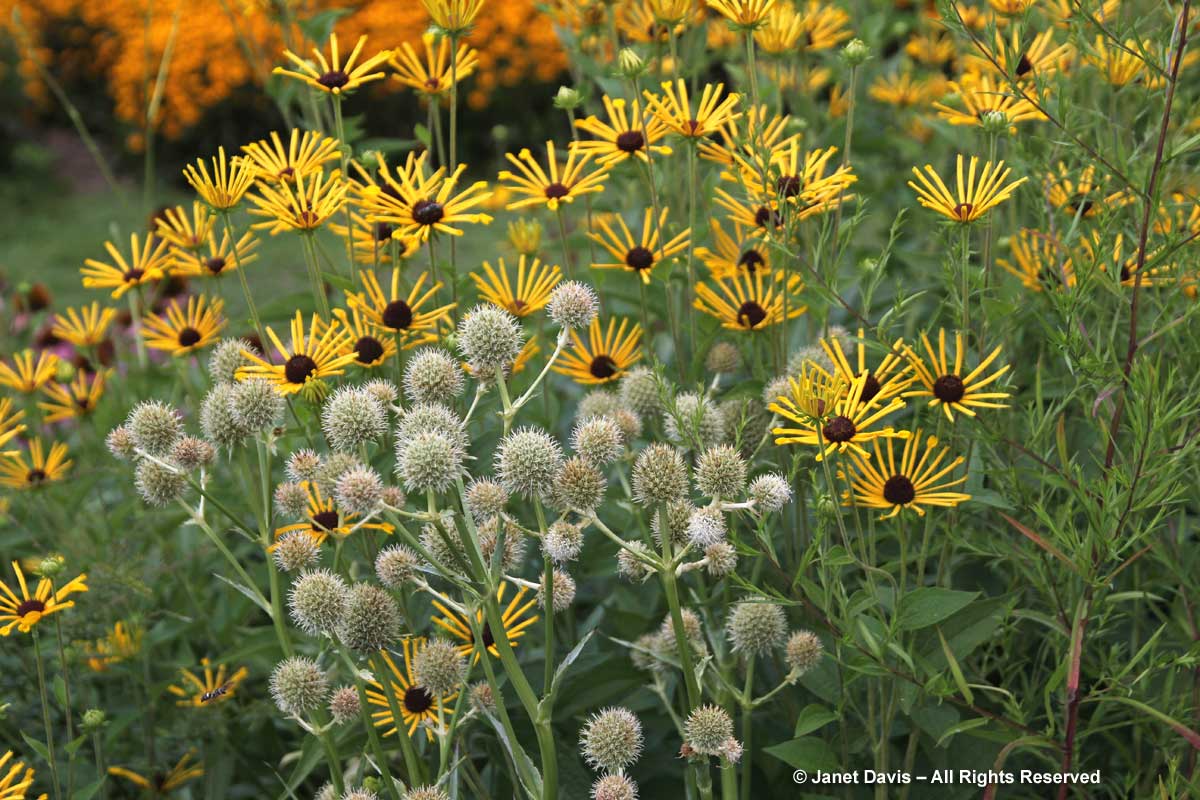
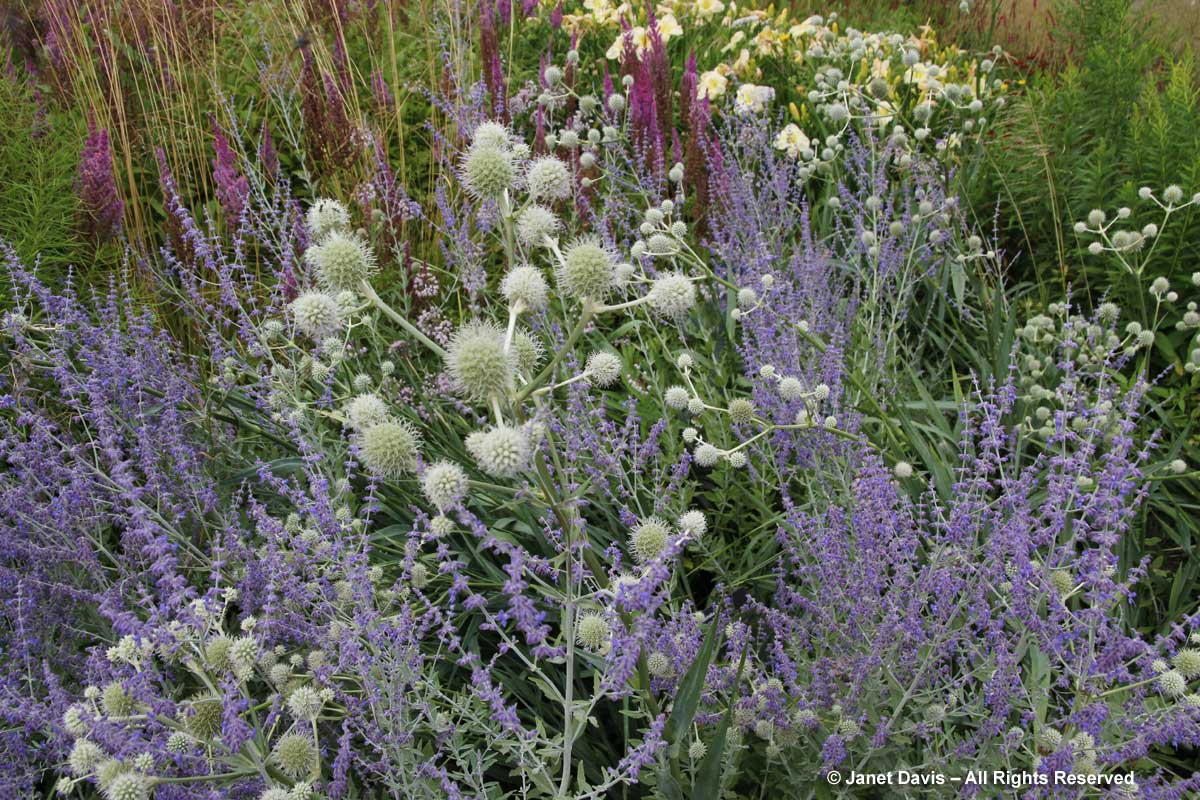
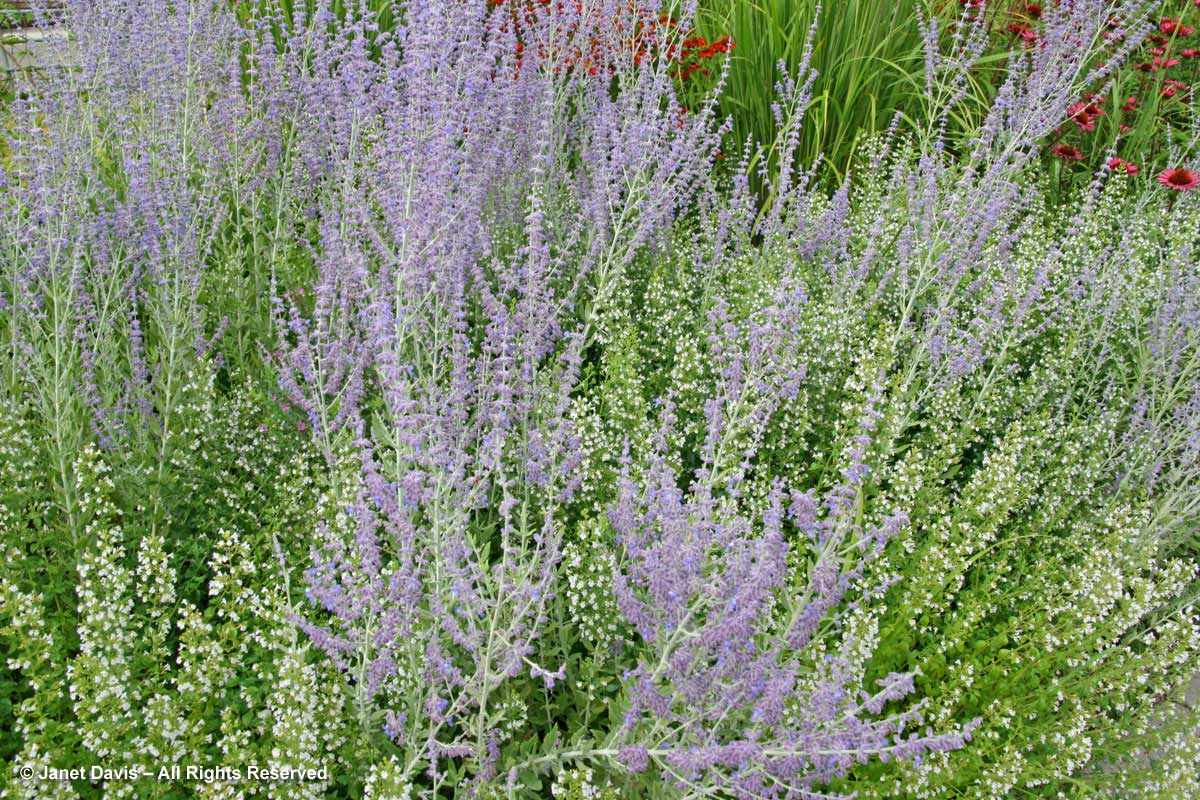
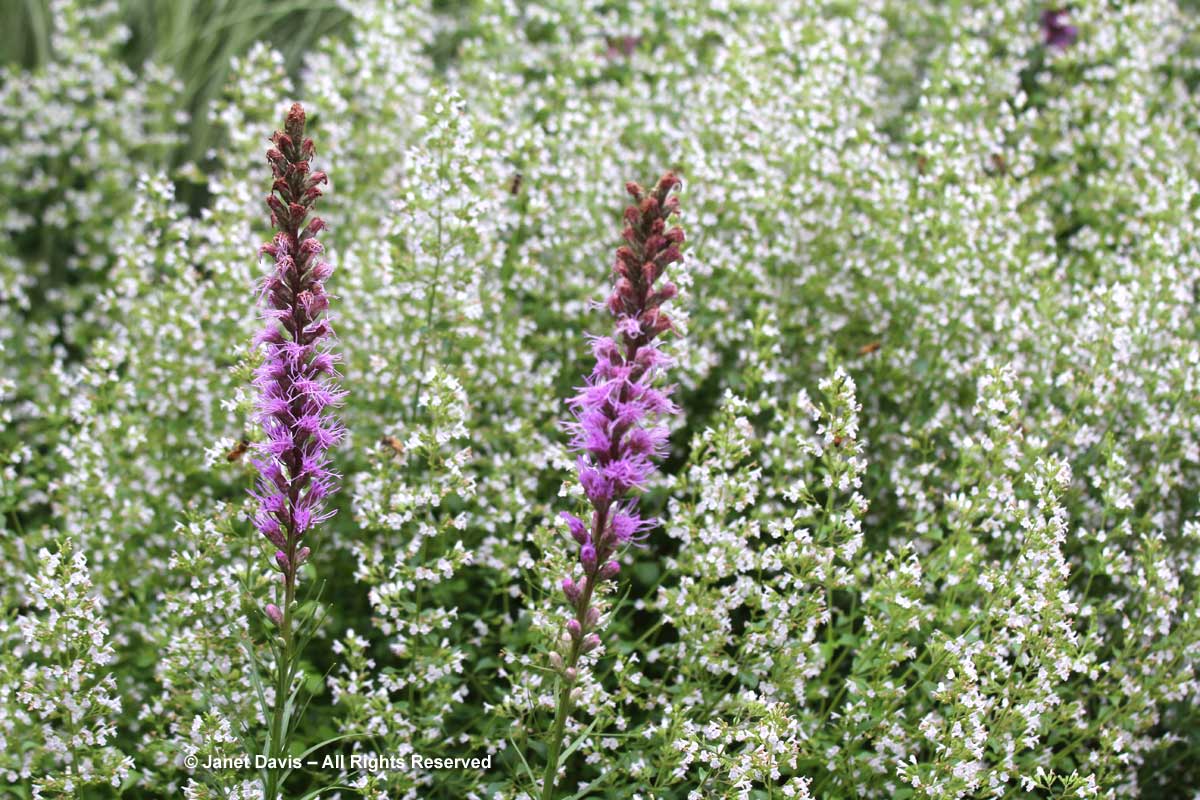
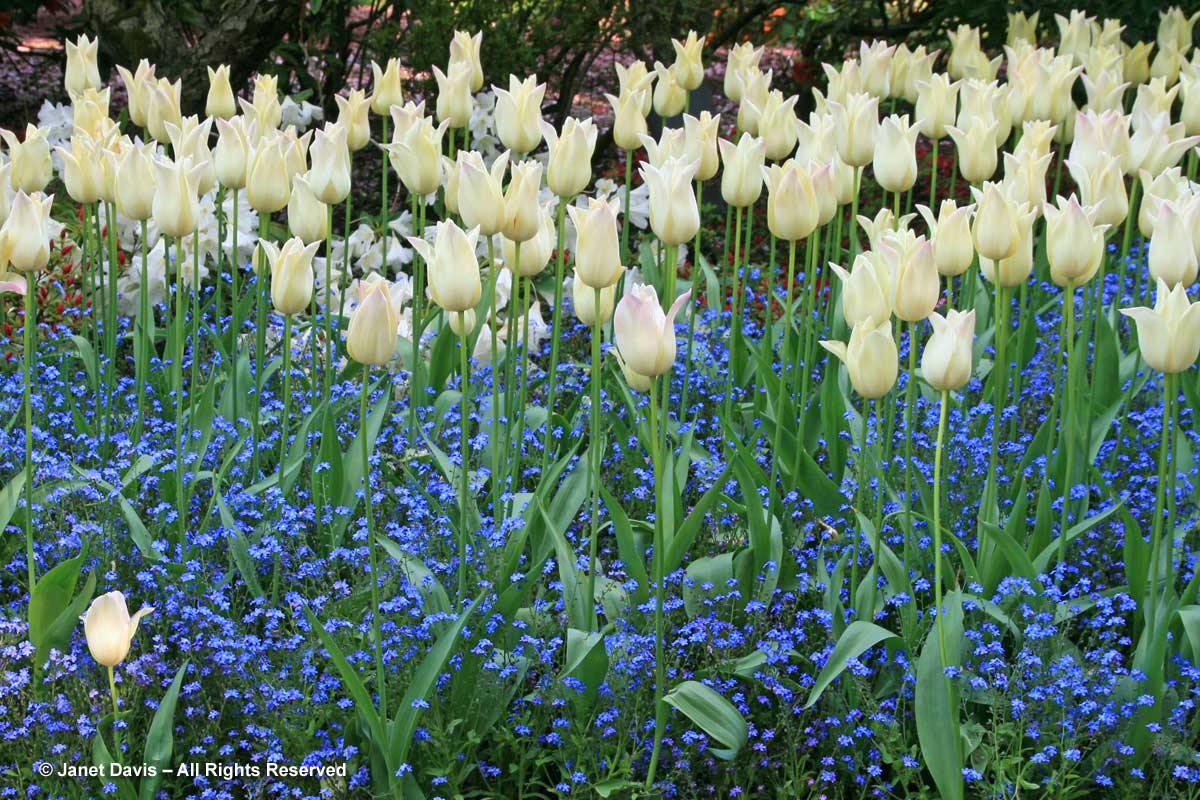
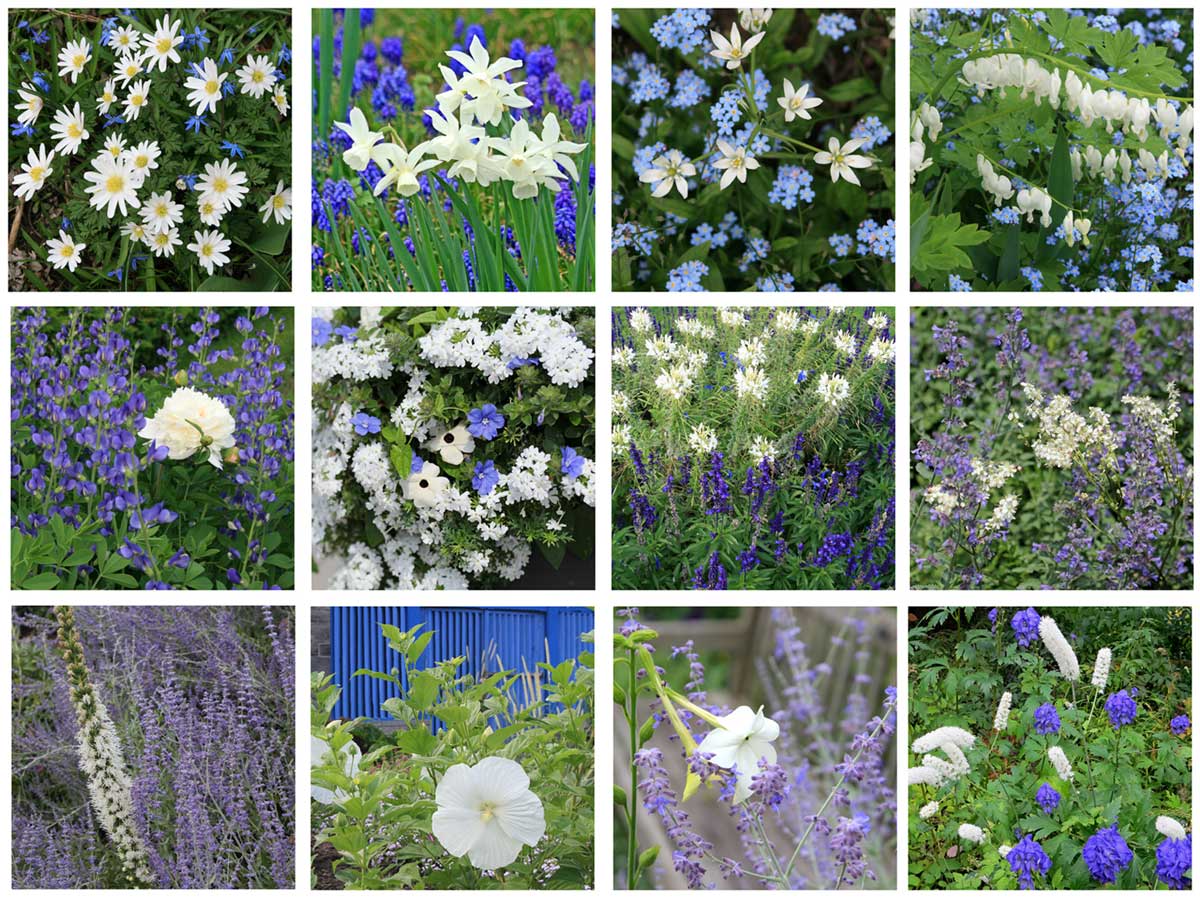
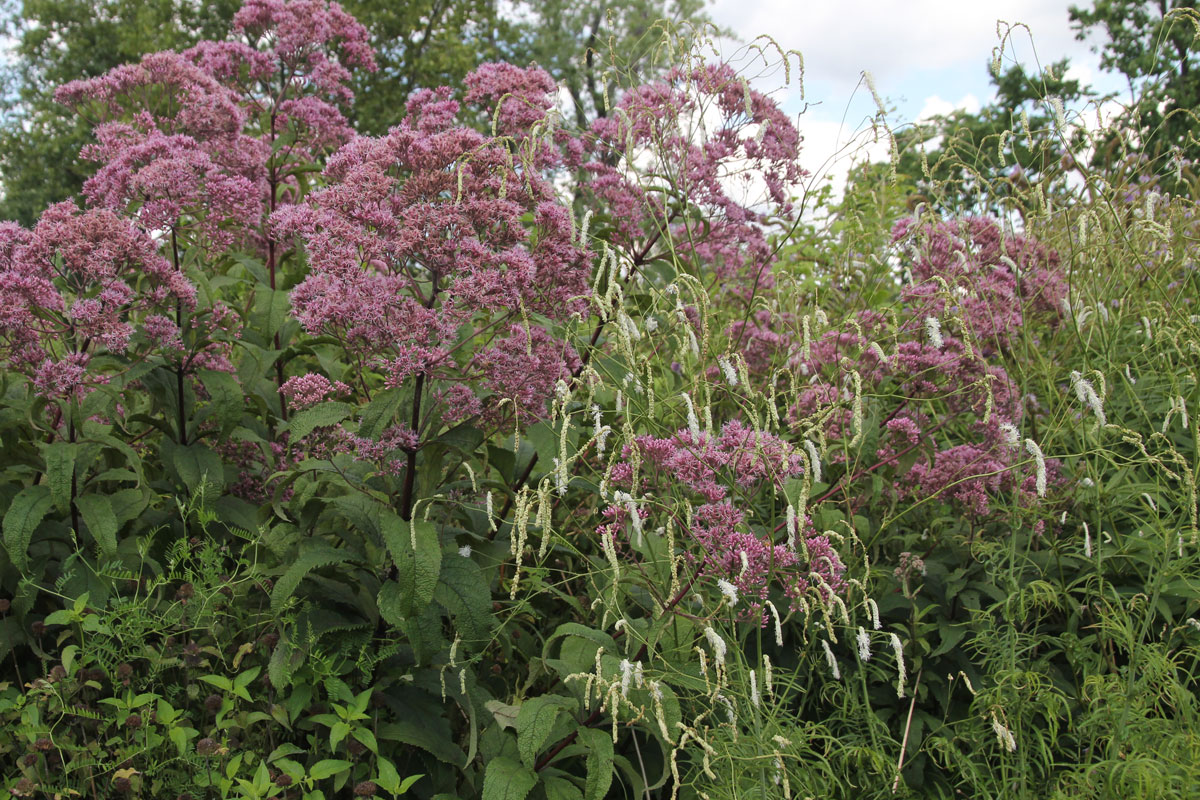
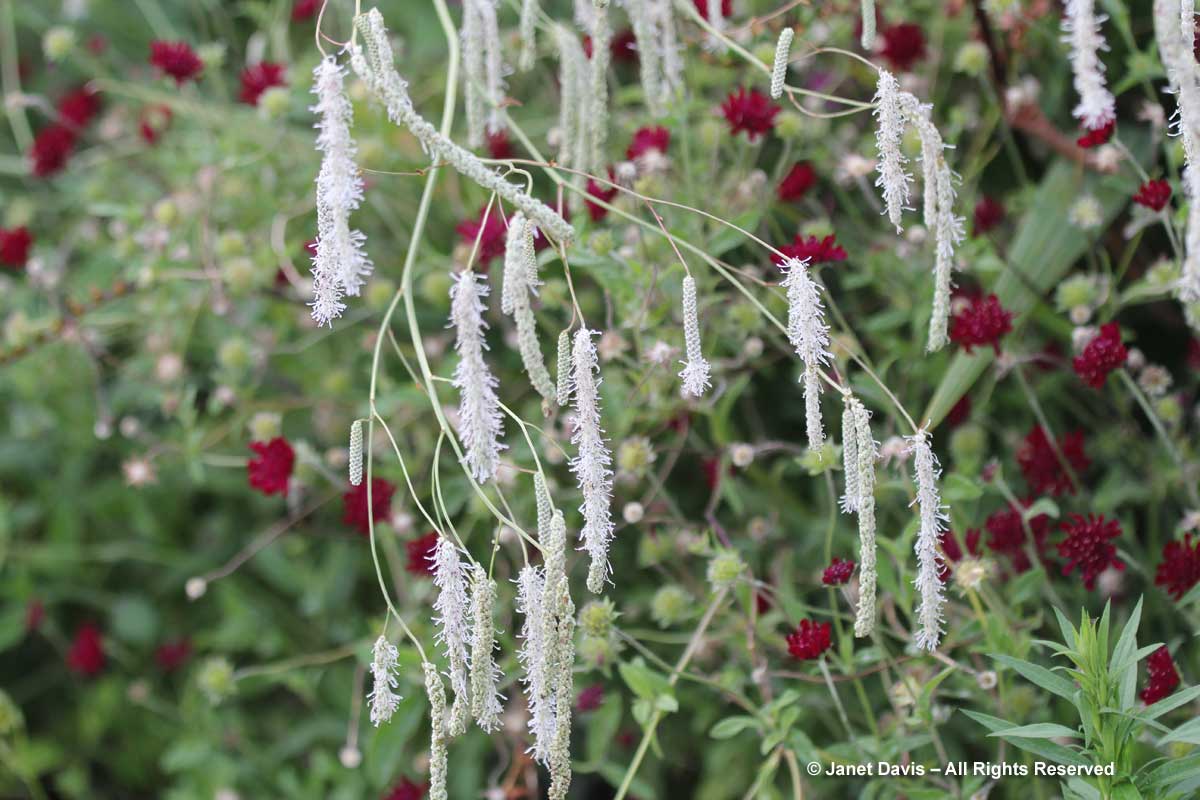
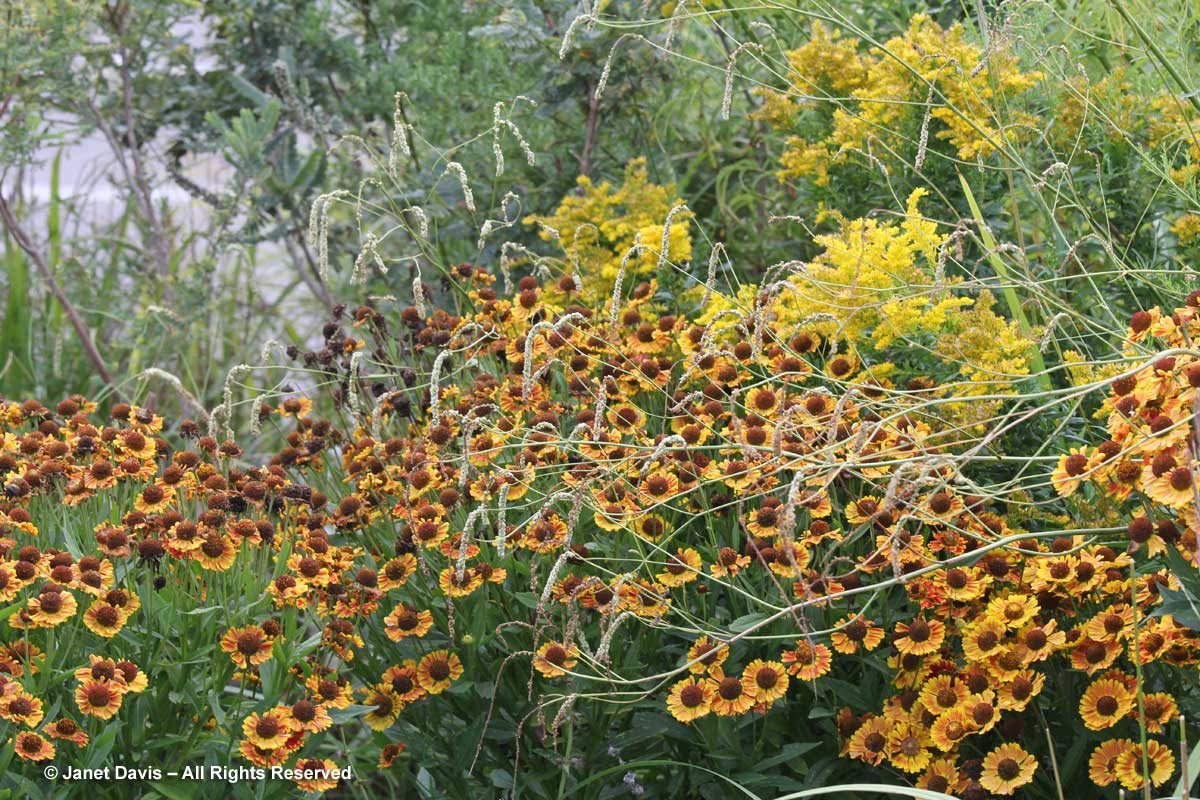
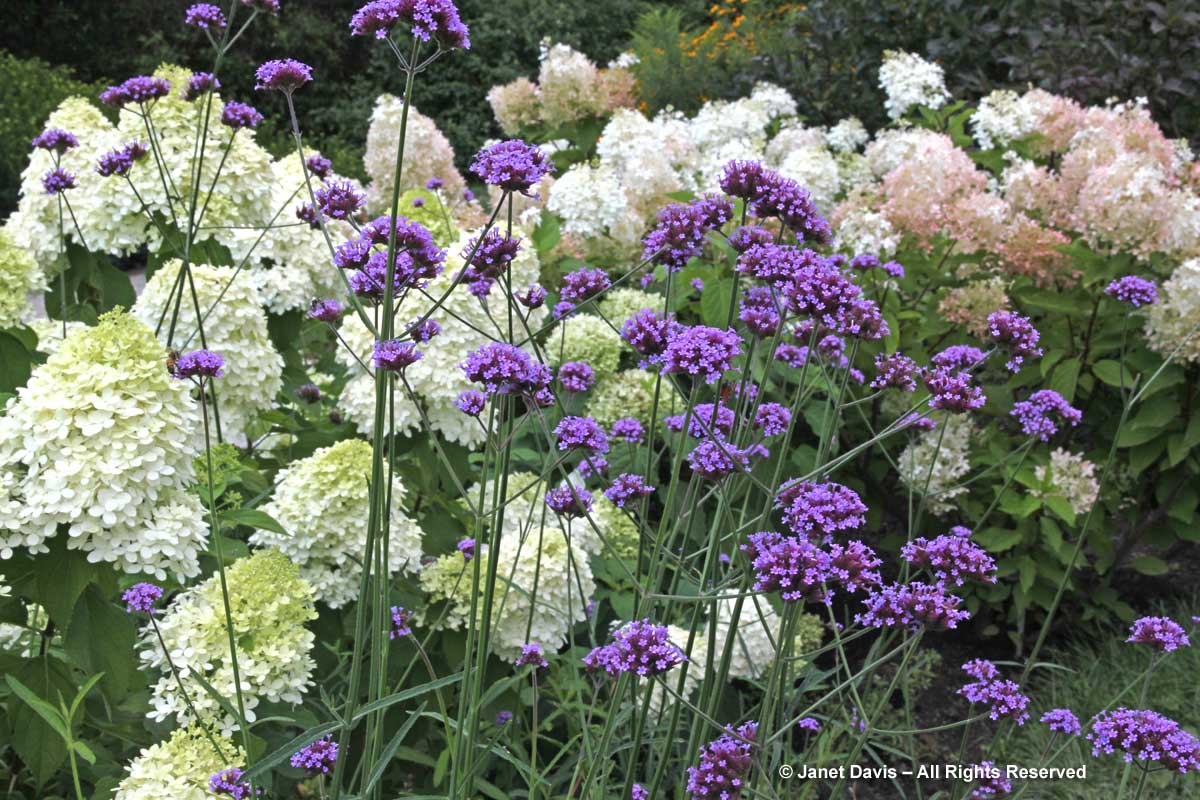
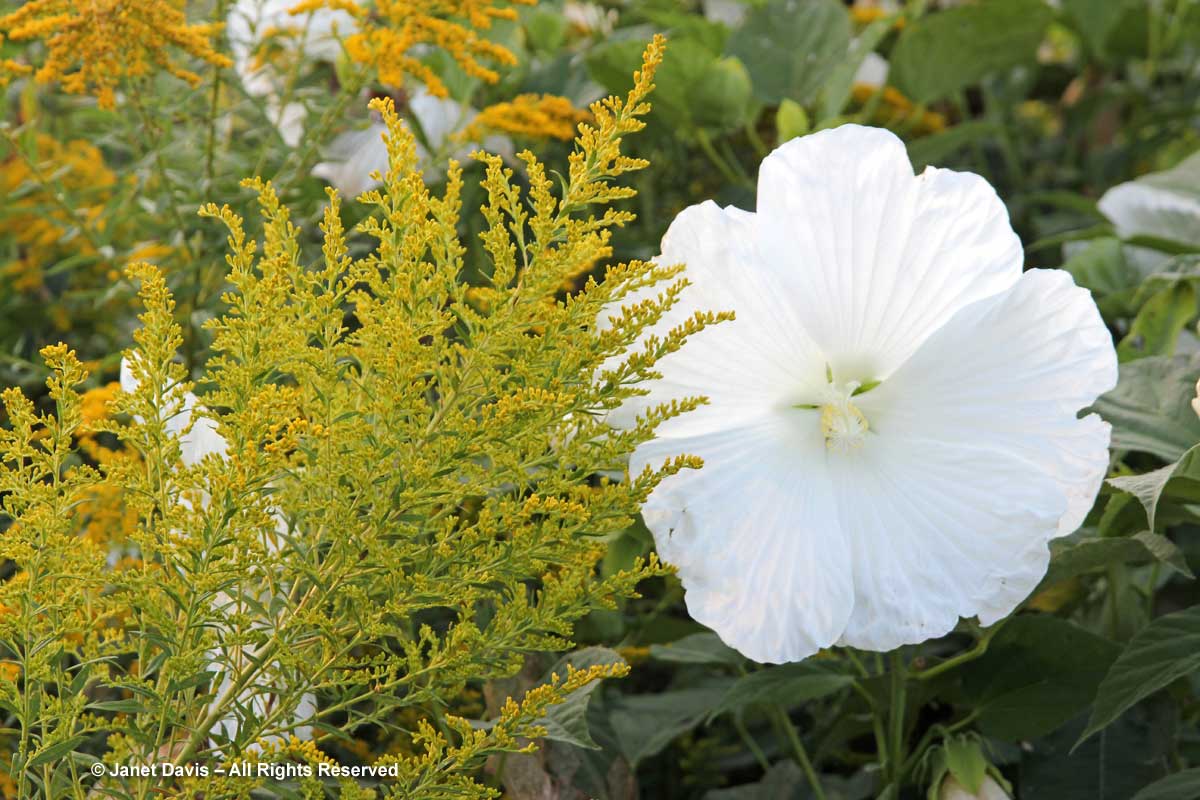
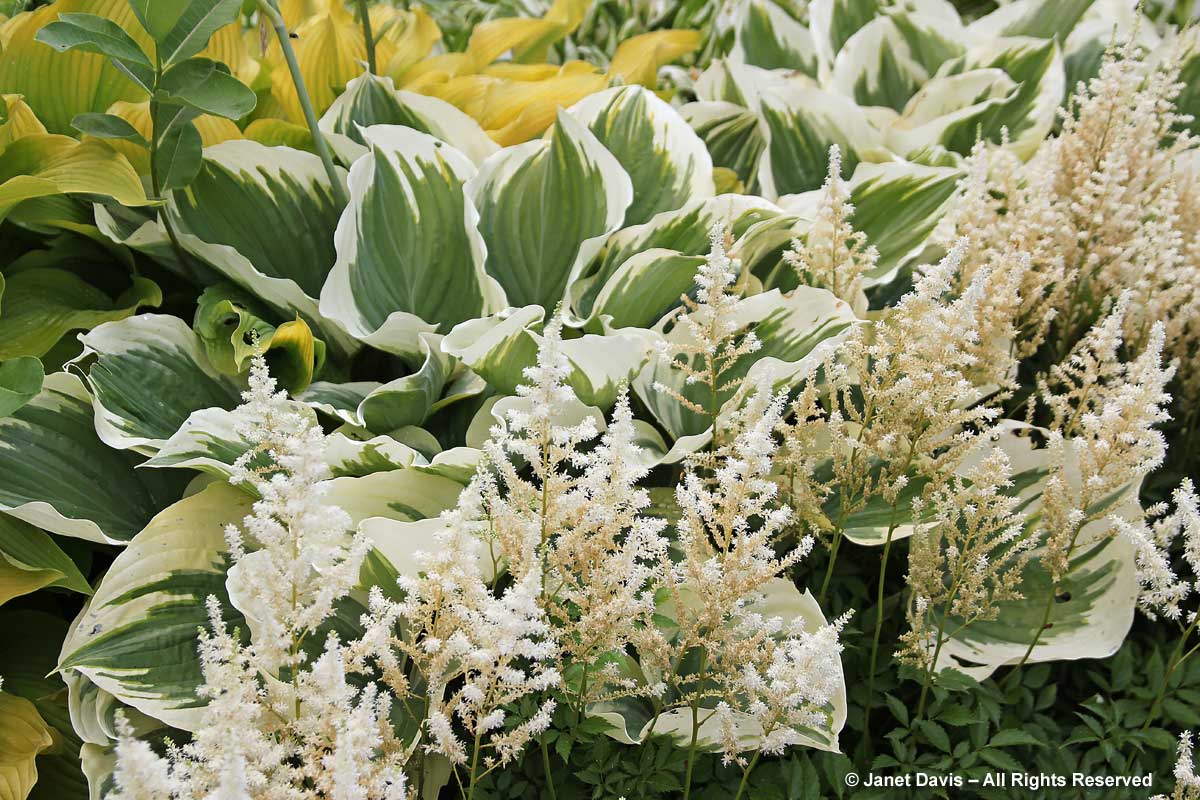
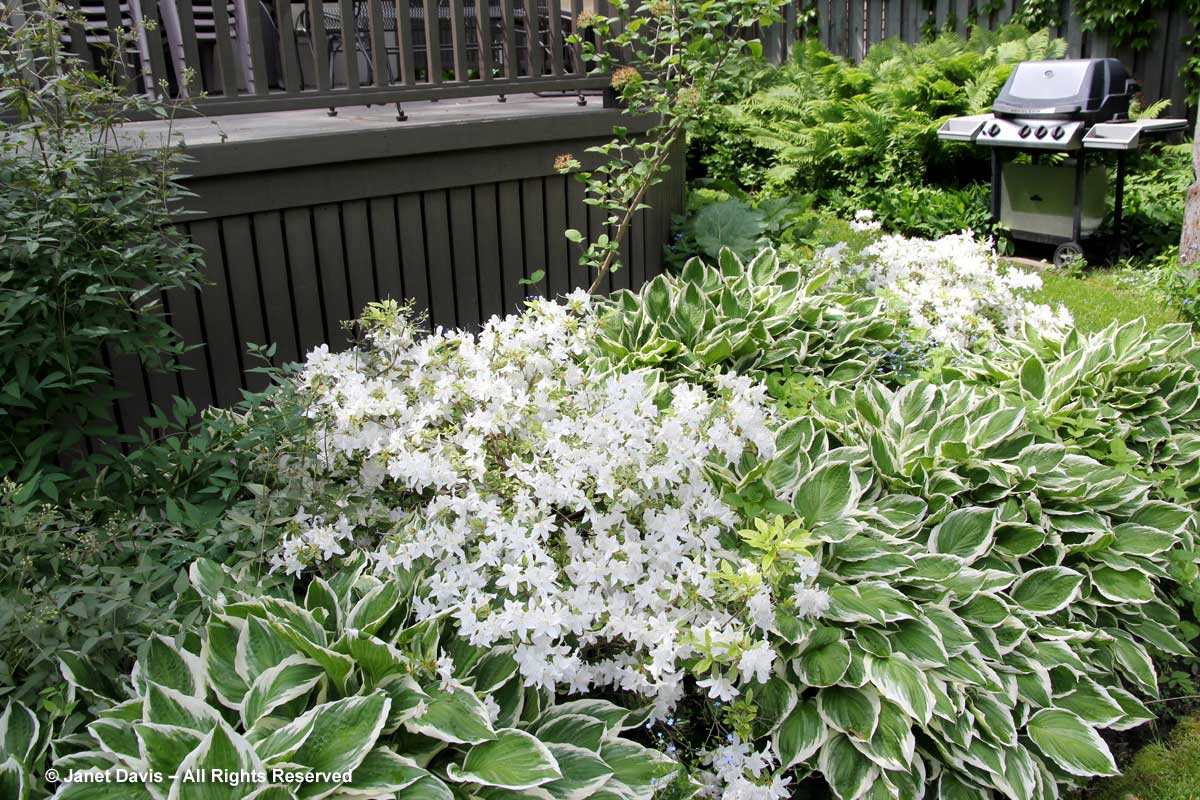
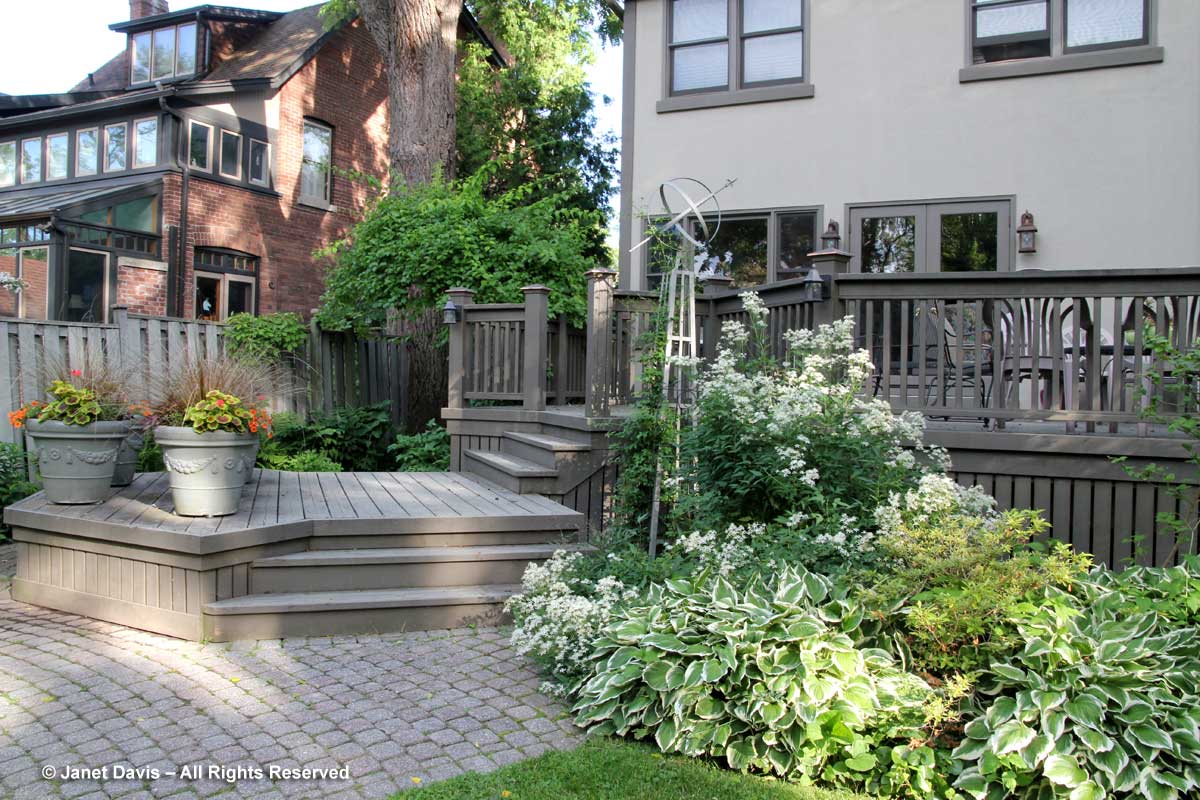
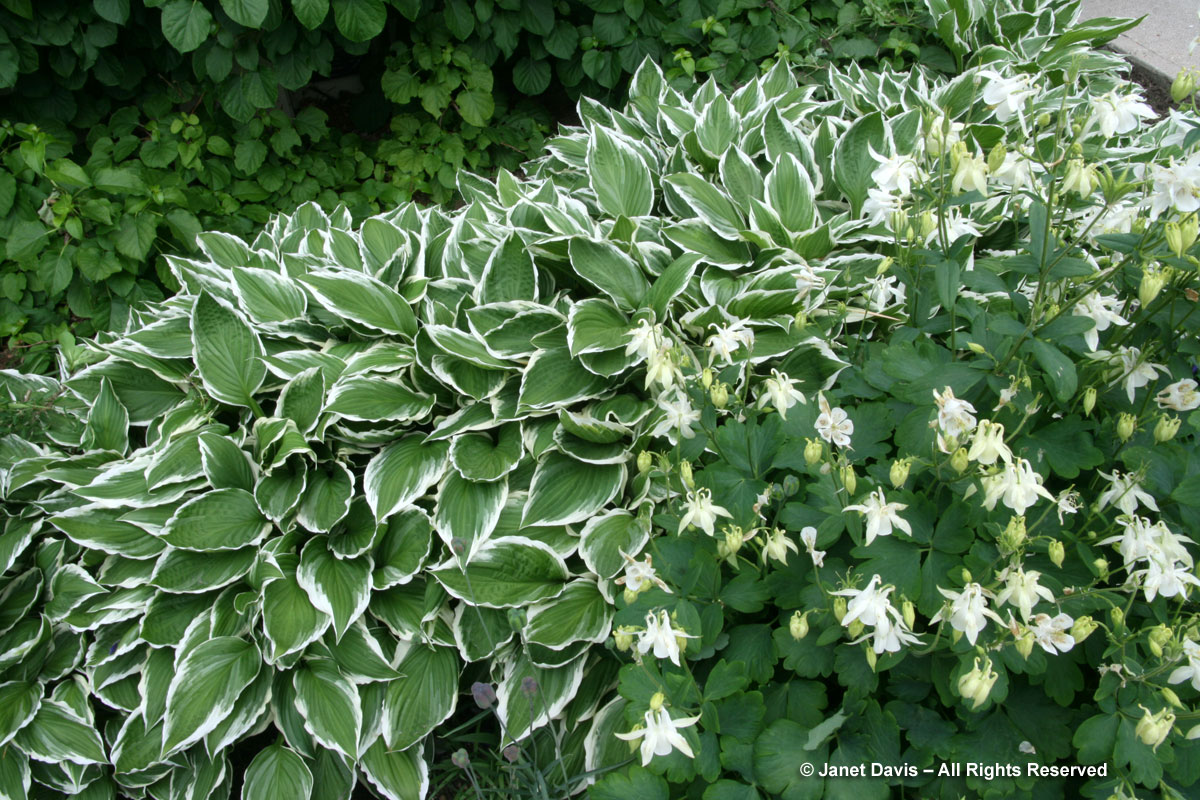
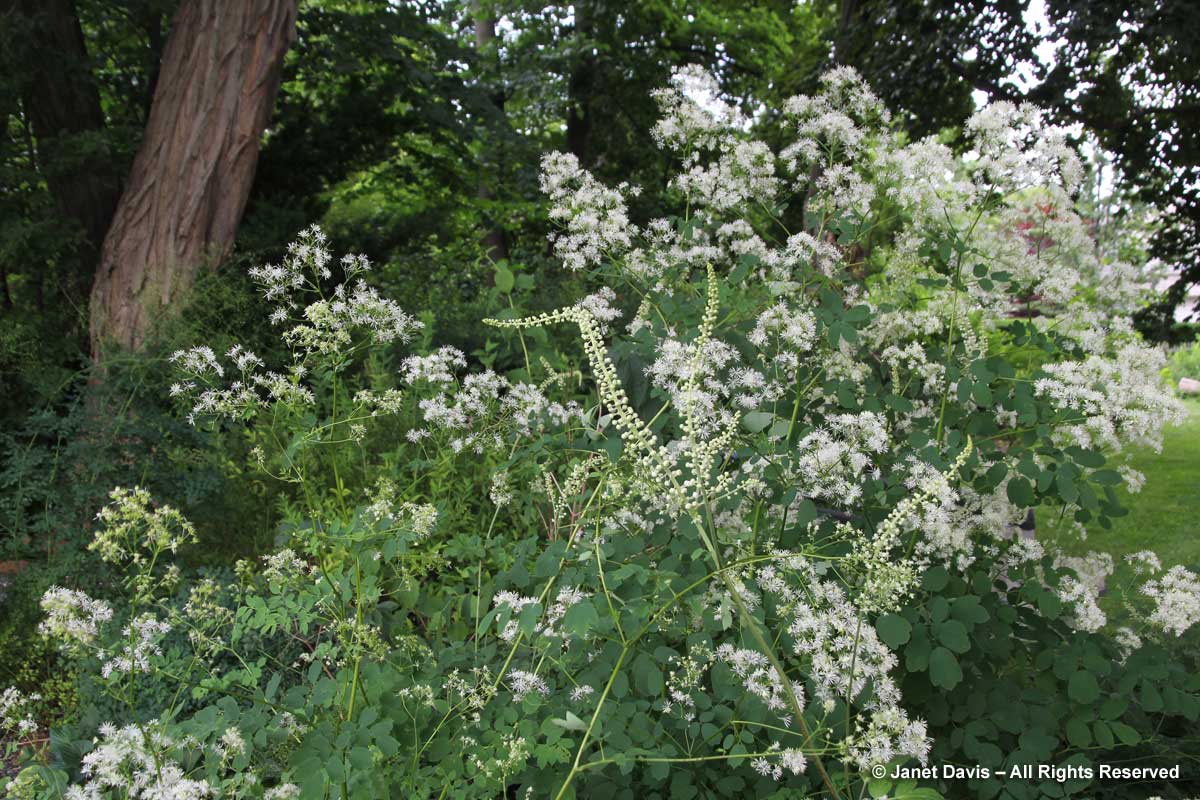
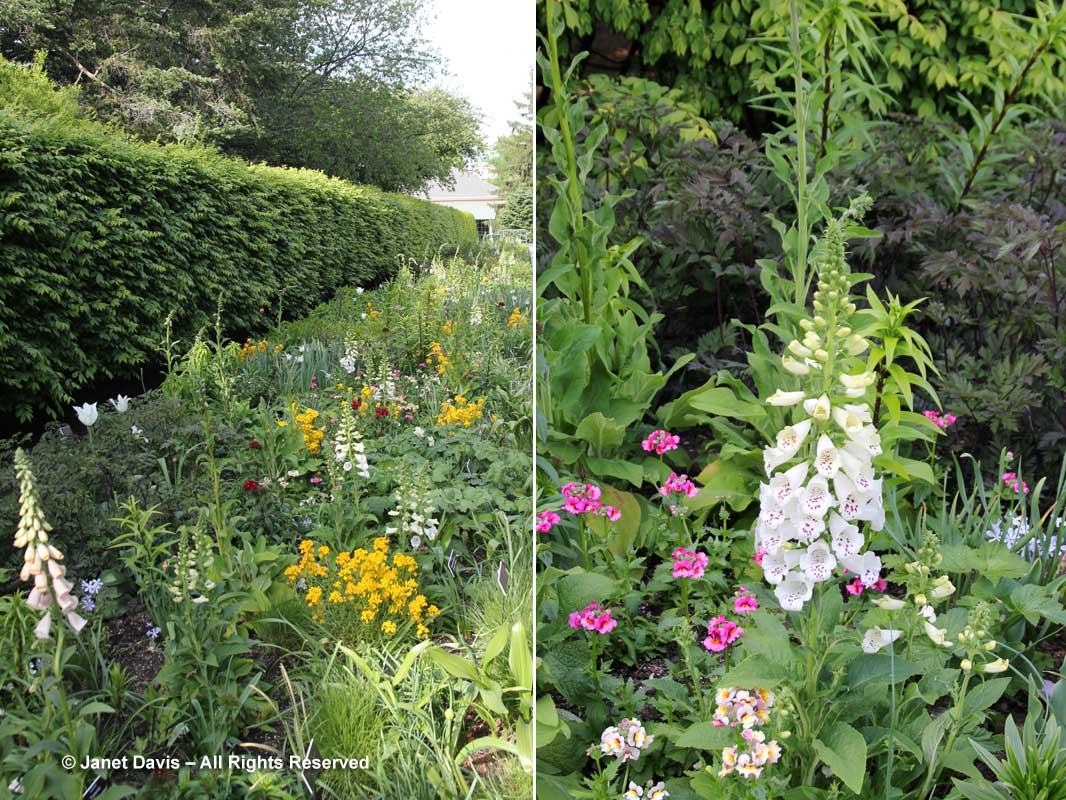
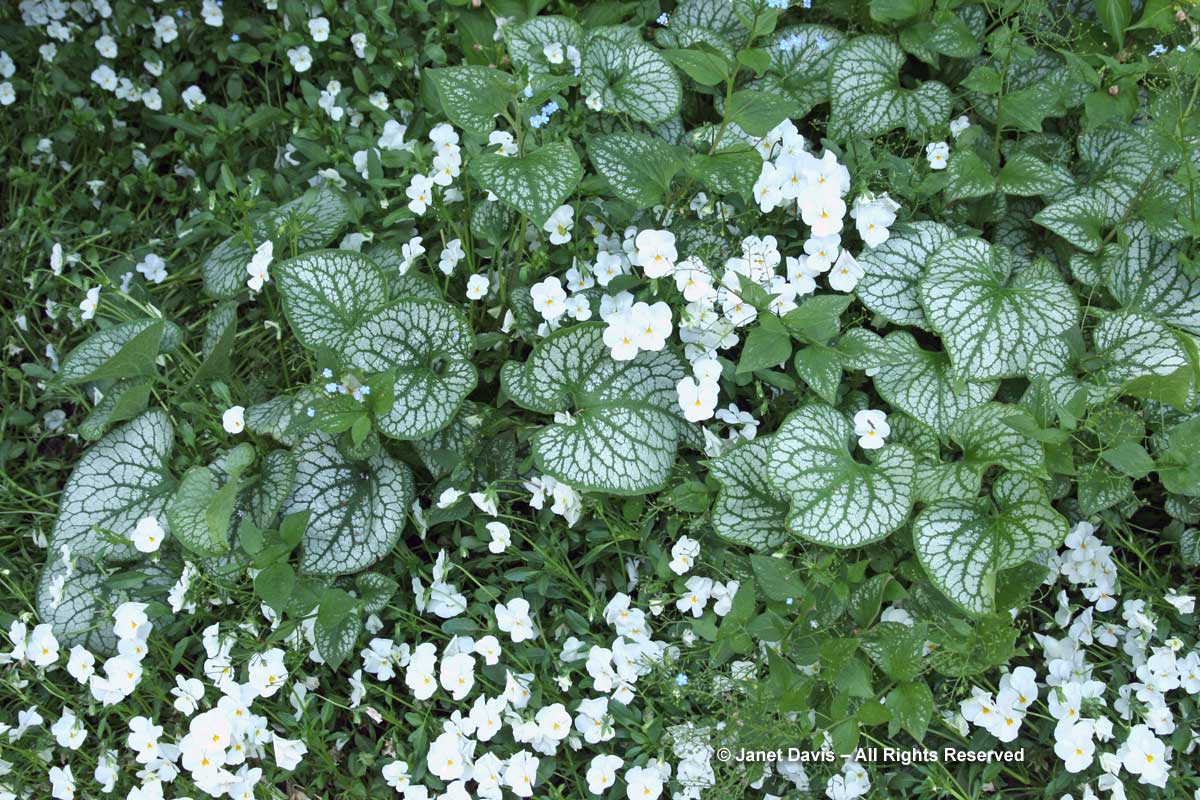
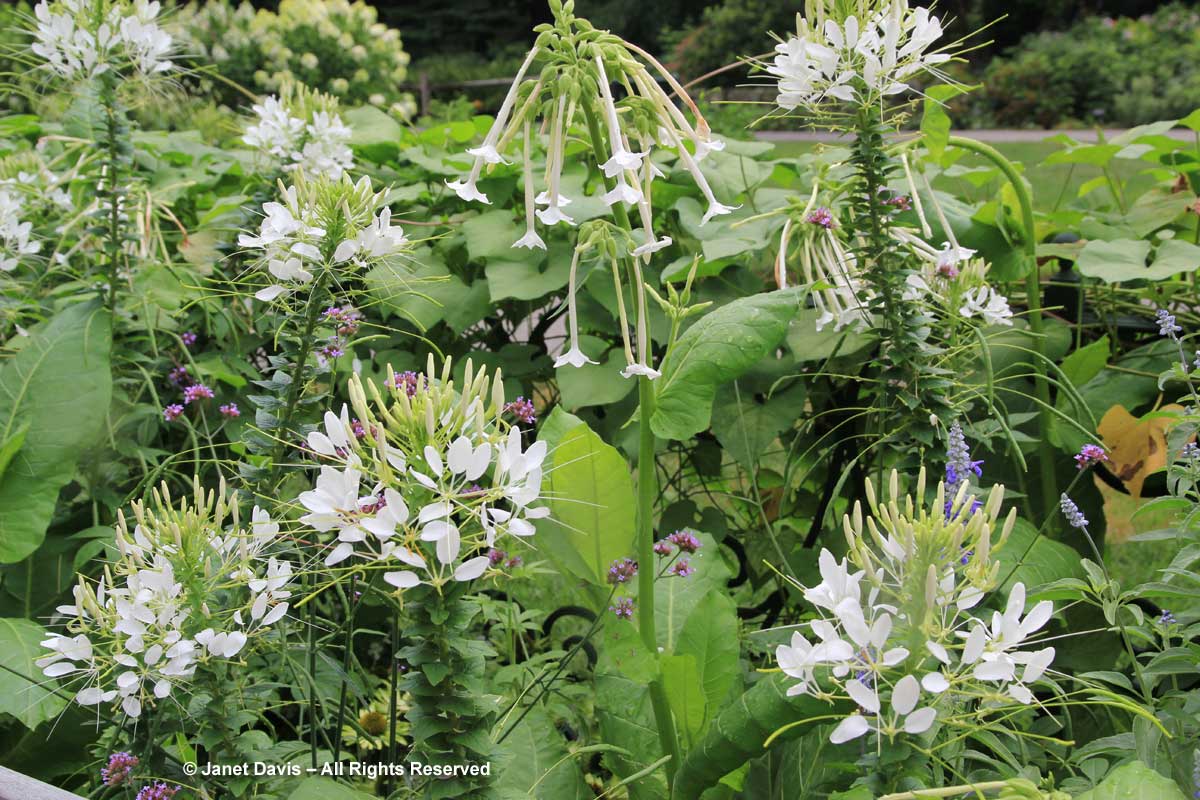
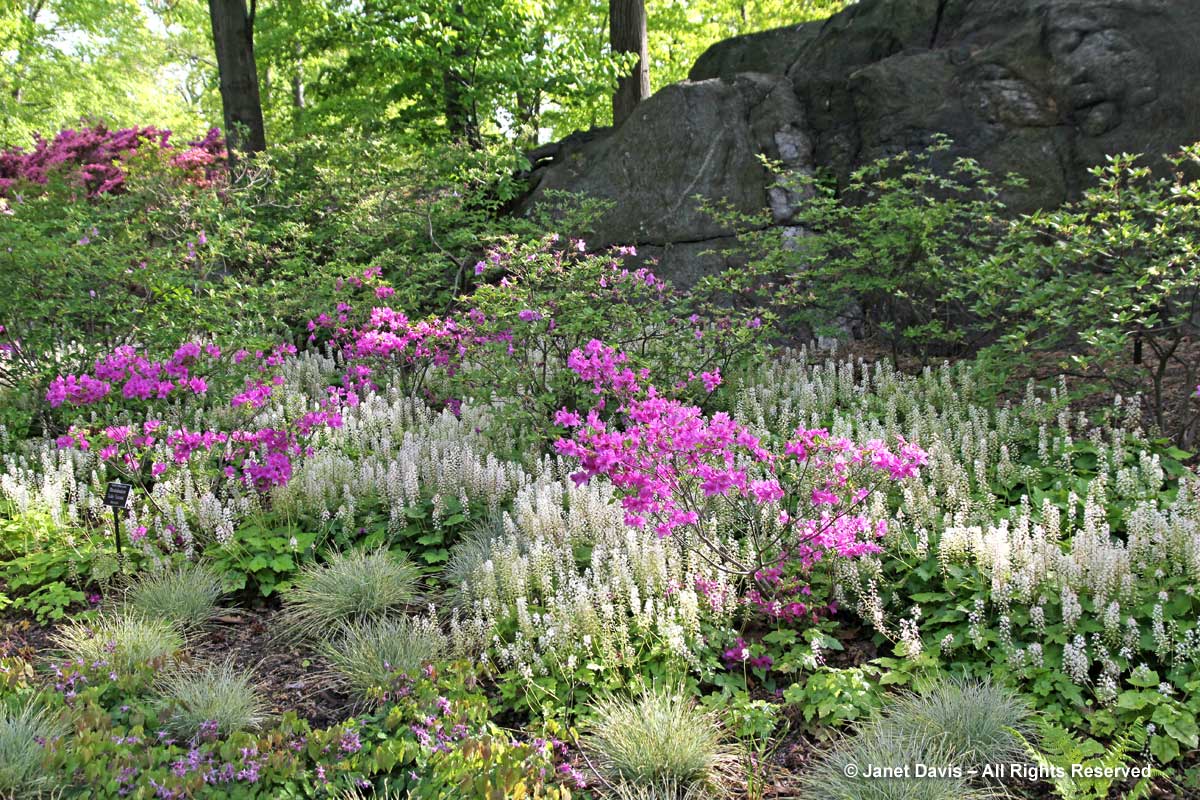
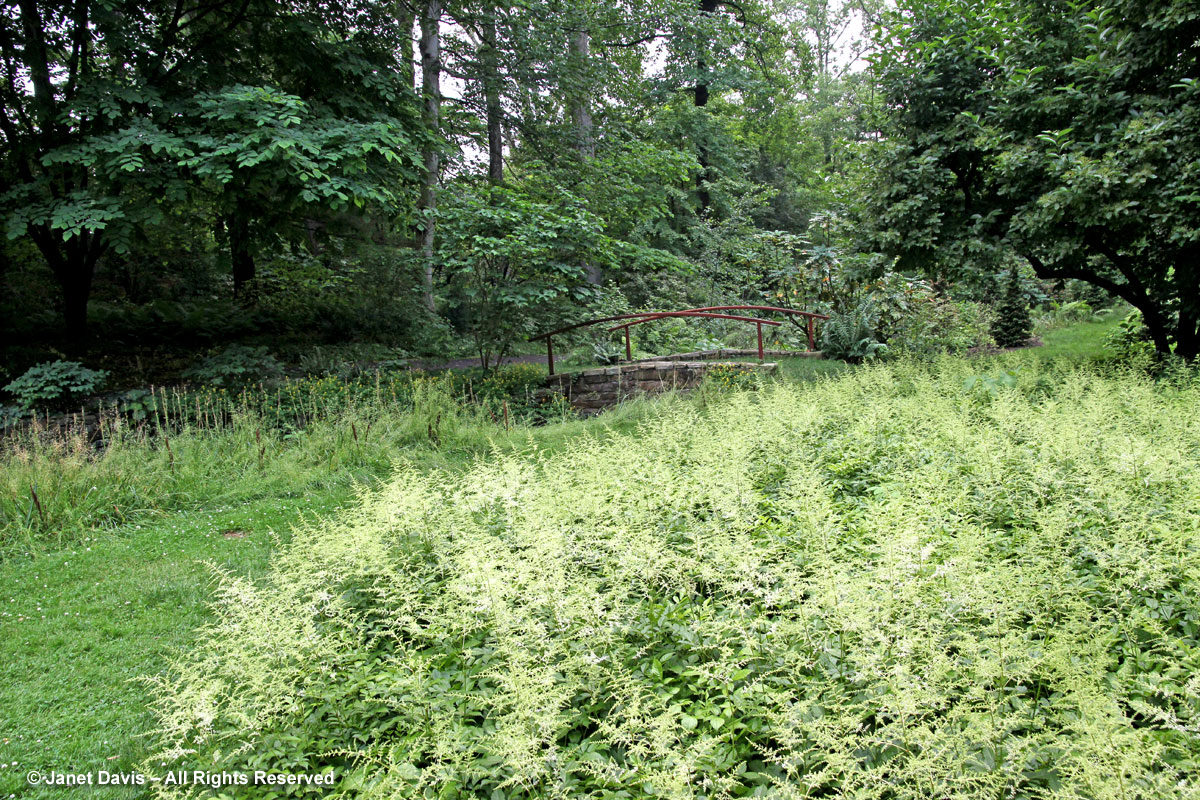
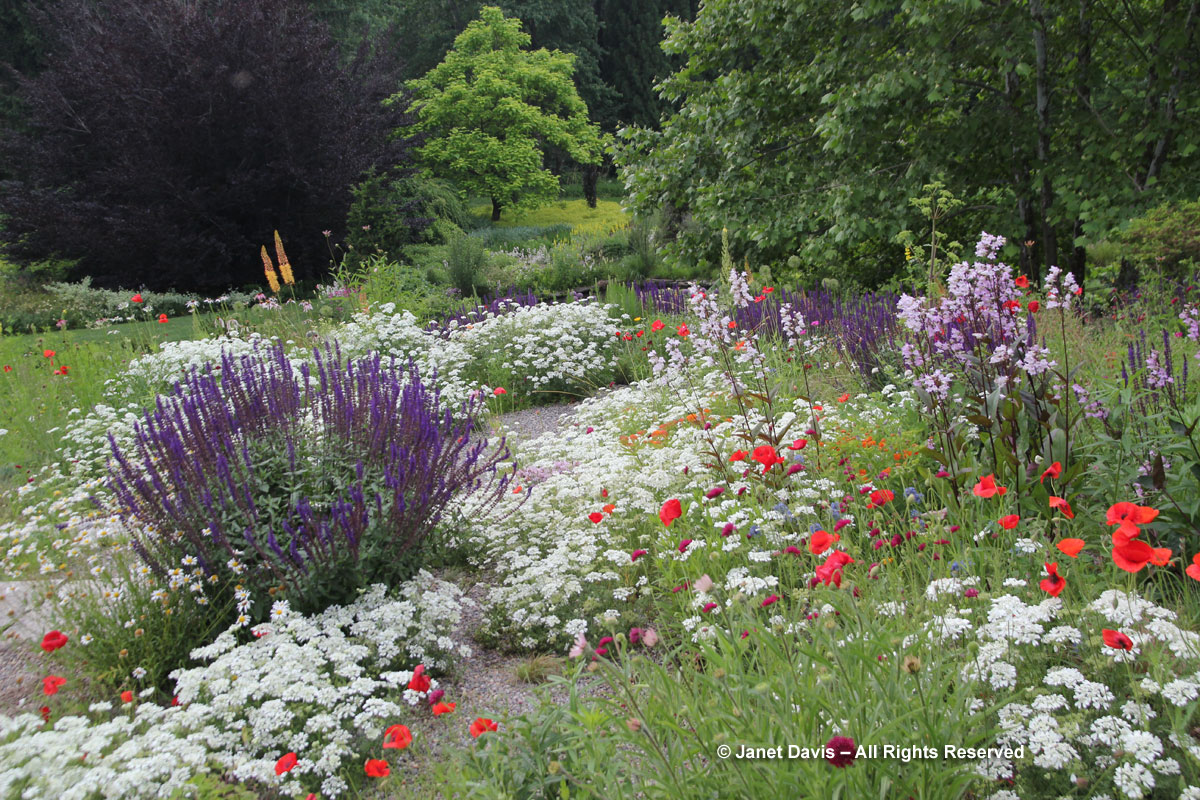
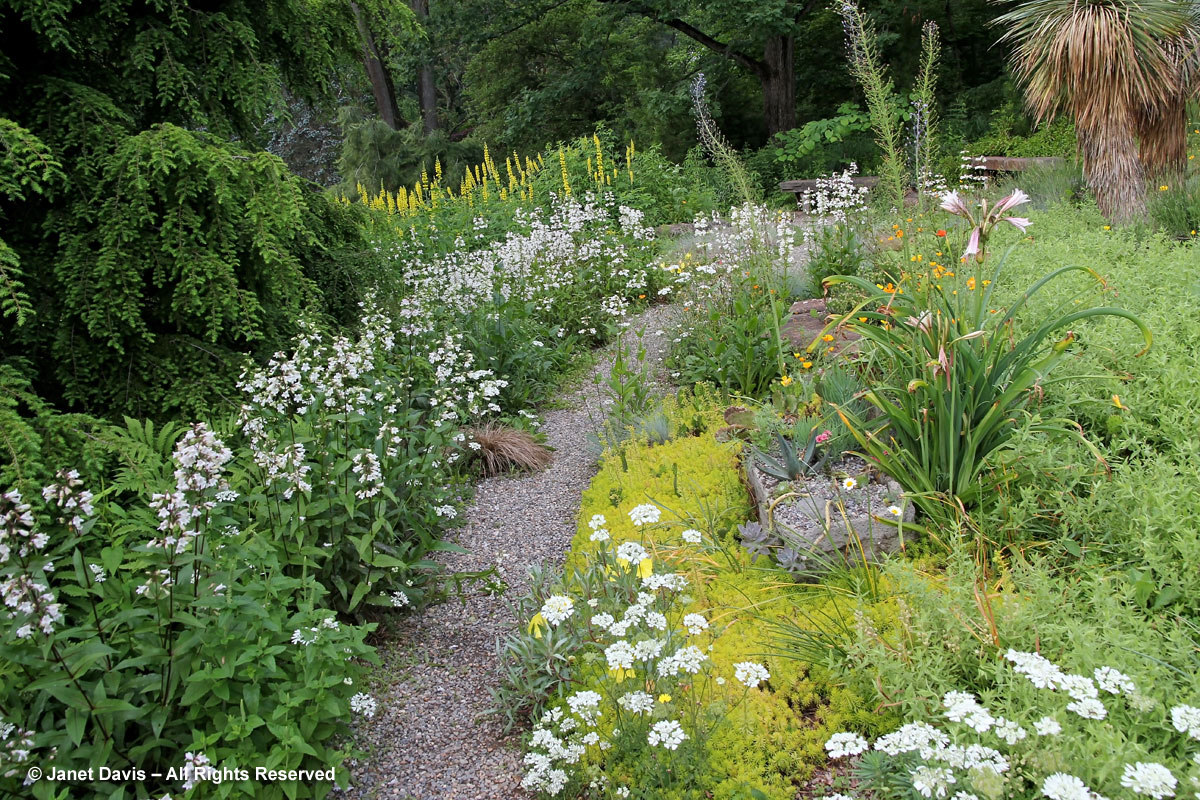
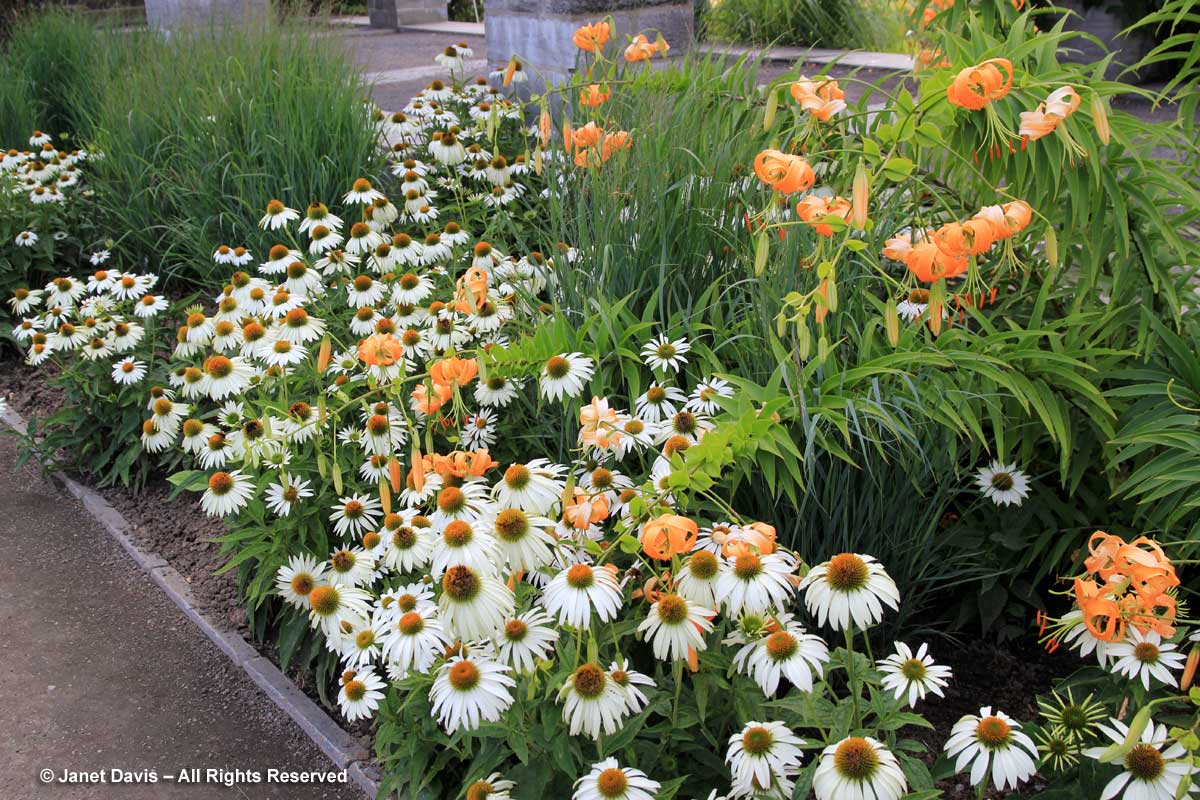
Another lovely post, Janet.
Thank you, Aldona! Lots of familiar scenes there for you. xo
You’ve shown us some amazing combinations, Janet. My three favourite: the cloud of Bowman’s root at the TBG; the white burnet with knautia macedonica; the white violets with Brunnera ‘Jack Frost’. Fabulous, all of them.
Thanks, Pat. All lovely choices. I’m partial to that wispy burnet. I should try the Bowman’s root. Apart from the TBG, people seem to love it.
Please, please tell me the name of the white ‘propeller’ like flower, top row, second from the left in the collage of photos right under the title, Garden Design using White Flowers. Thank you so much! It was seen as a spring wildflower here in Ottawa.
Bernita
Bernita – That is showy trillium, Trillium grandiflorum.